After I had had a stroll around the lovely town of Riquewihr in Alsace region, I headed for yet another picturesque town and that was Kaysersberg. But, before reaching my new destination, I enjoyed driving through the almost endless vineyards that are omnipresent in this area.
 Alsace wine region
Alsace wine region
Namely, I was driving along the Alsace Wine Route (Route des vins d’Alsace).
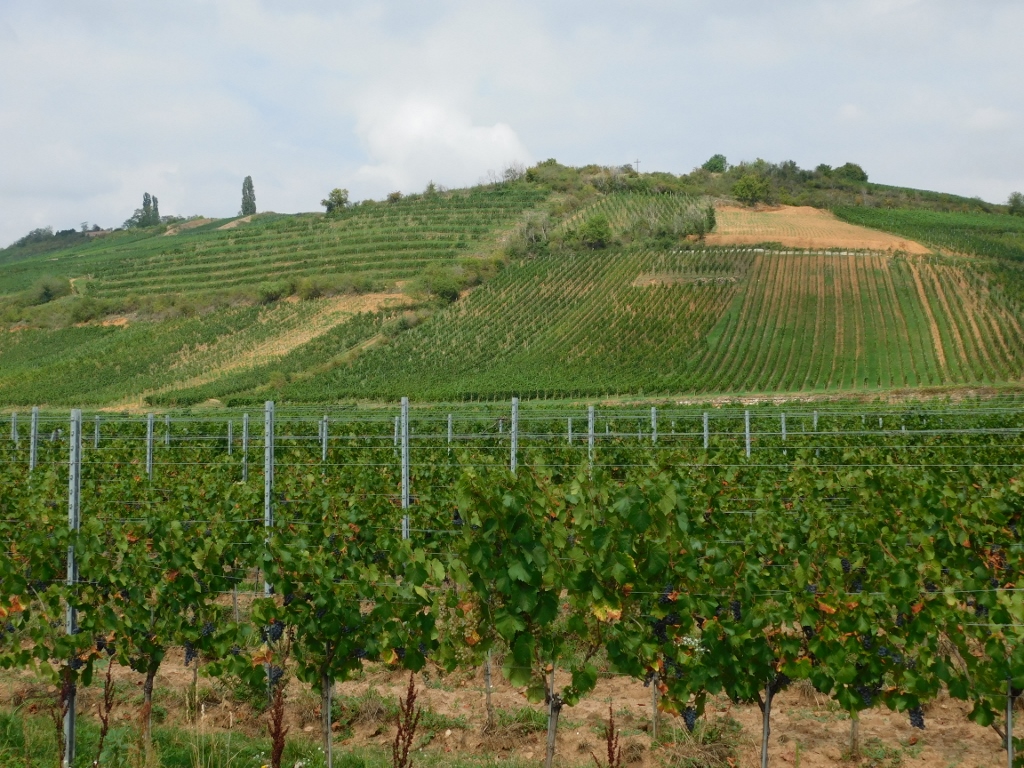 Alsace wine region
Alsace wine region
By the way, Alsace is the name of a cultural region in the east of France that spreads along the west bank of the Rhine and borders Germany and Switzerland. I will not go back in the past too much now, suffice to mention that in 1871 Germany annexed this area, but it was returned to France in 1919. During WWII, Germany annexed it formally again, but since 1945 it has been again a part of France.
What was interesting for me is that the Alsace Wine Route is the oldest wine route in France. I don’t think I have ever seen more vineyards anywhere else. On the other hand, this has probably nothing to do with Alsace, but rather with my choice of travel destinations, but in any case the area is exceptionally beautiful and I thoroughly enjoyed while driving there.
Soon I approached Kaysersberg and when I reached the centre of this small town, I had to drive around a little until I found a parking lot, but eventually this was resolved well.
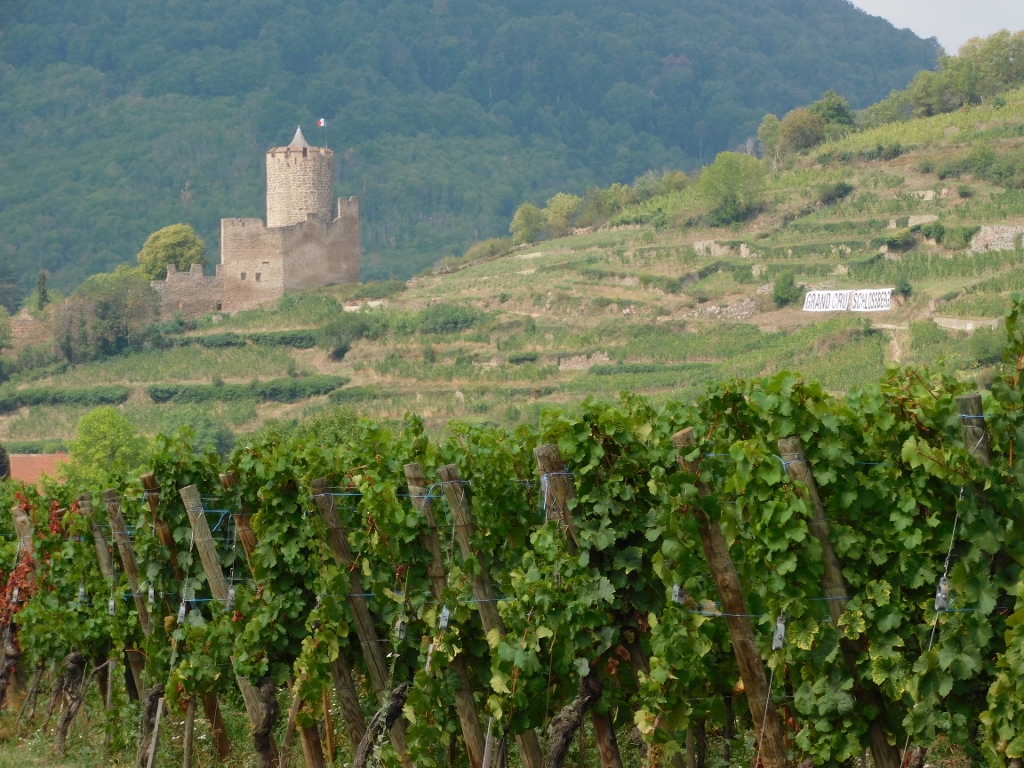 Vineyards and a part of Kaysersberg
Vineyards and a part of Kaysersberg
Kaysersberg is a typical Alsace place and its size puts it between a larger village and a smaller town in the centre of which there are streets with numerous old houses. Some of these houses date back to the 16th century.
But, although charming and picturesque houses may seem romantic, remains of a fortification that can be seen on an elevation above the town clearly suggest that in the past Kaysersberg had a pronounced strategic importance and it is certain that there used to be battles here. I should say right away that I did not go up to the fortress, since I had only about an hour for a walk around the centre.
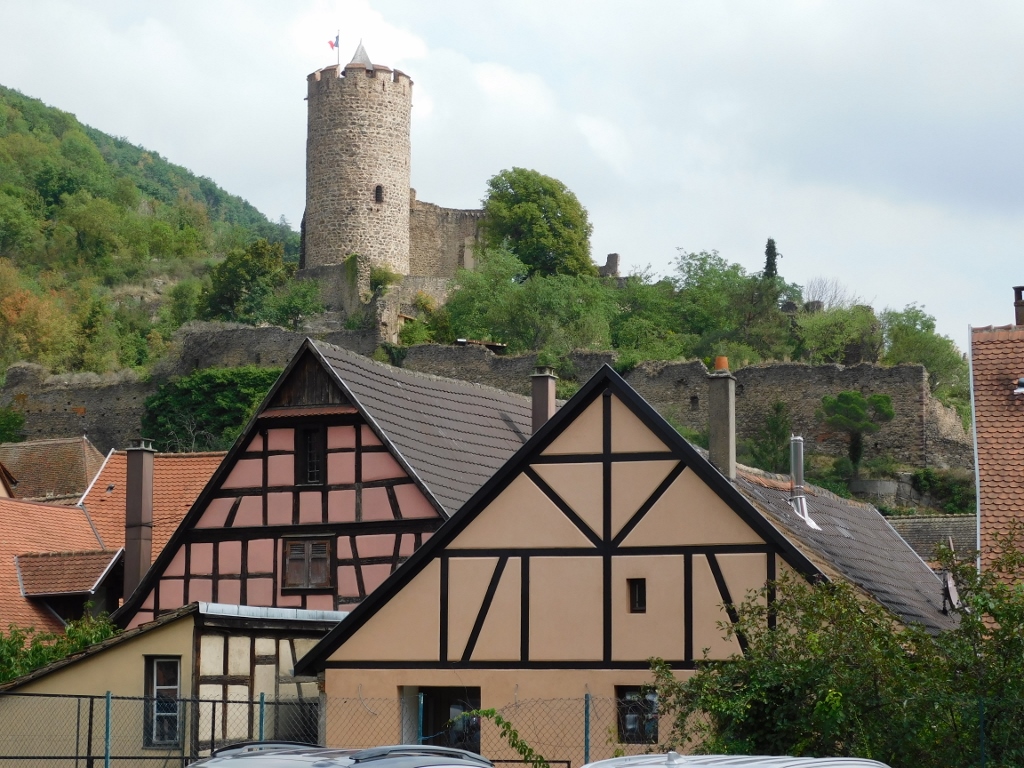 Kaysersberg
Kaysersberg
The first mention of the town in history was recorded in 1227 when the then German emperor issued an order to build or restore a castle, while the name of the town clearly suggests German influence since it means “Emperor’s Mountain.” The town became a part of France in 1648 and in the 19th century Kaysersberg followed the destiny of Alsace that I have already written about and it moved from being the territory of France to being the territory of Germany several times, while now it is clearly a part of France.
As in the case of Riquewihr, here, too, I only strolled around the town, not having the time to stay here longer. On the other hand, the attraction of the place comes mostly from its beautiful, old and picturesque buildings, so I felt that a simple walk was enough.
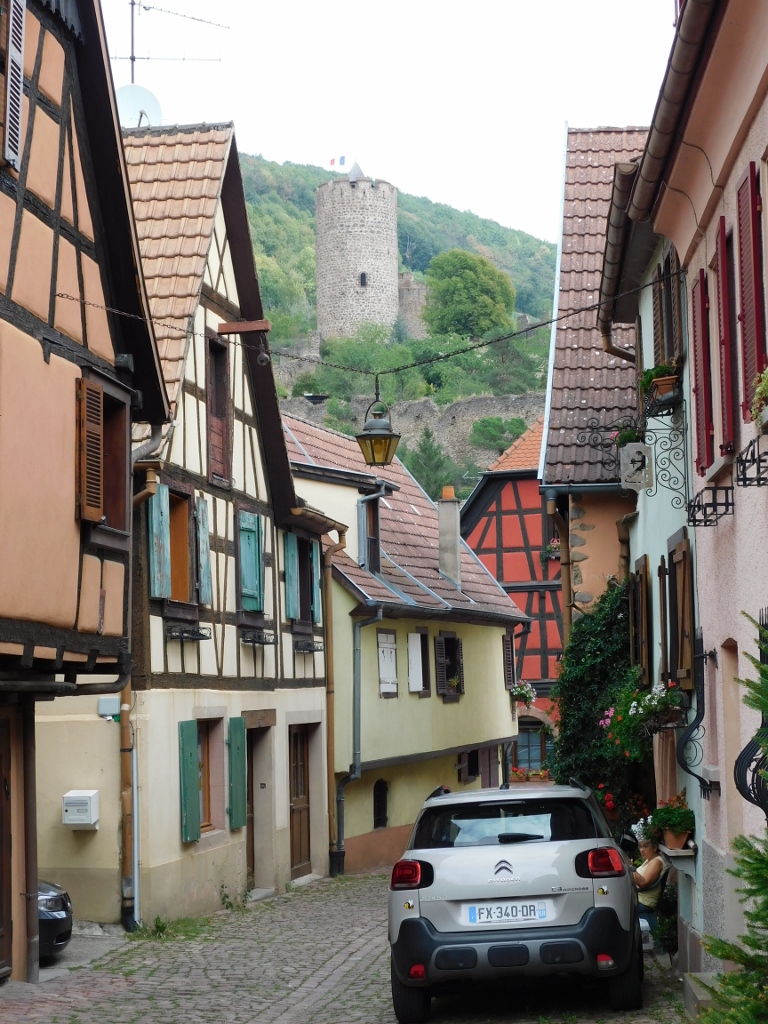 A side street in Kaysersberg leading from a parking lot to the centre
A side street in Kaysersberg leading from a parking lot to the centre
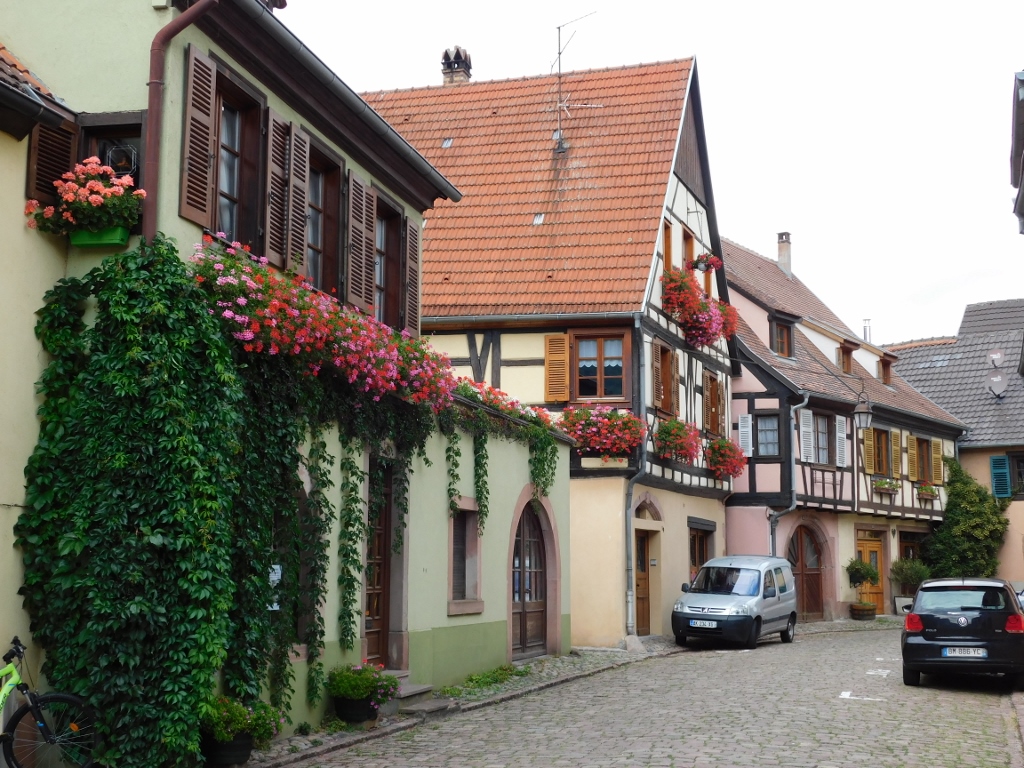 A side street in Kaysersberg leading from a parking lot to the centre
A side street in Kaysersberg leading from a parking lot to the centre
Even before reaching the main street, I noticed a passage between some houses and so I went closer to the river Weiss that flows through Kaysersberg only in order to have a look at it. It all looked lovely.
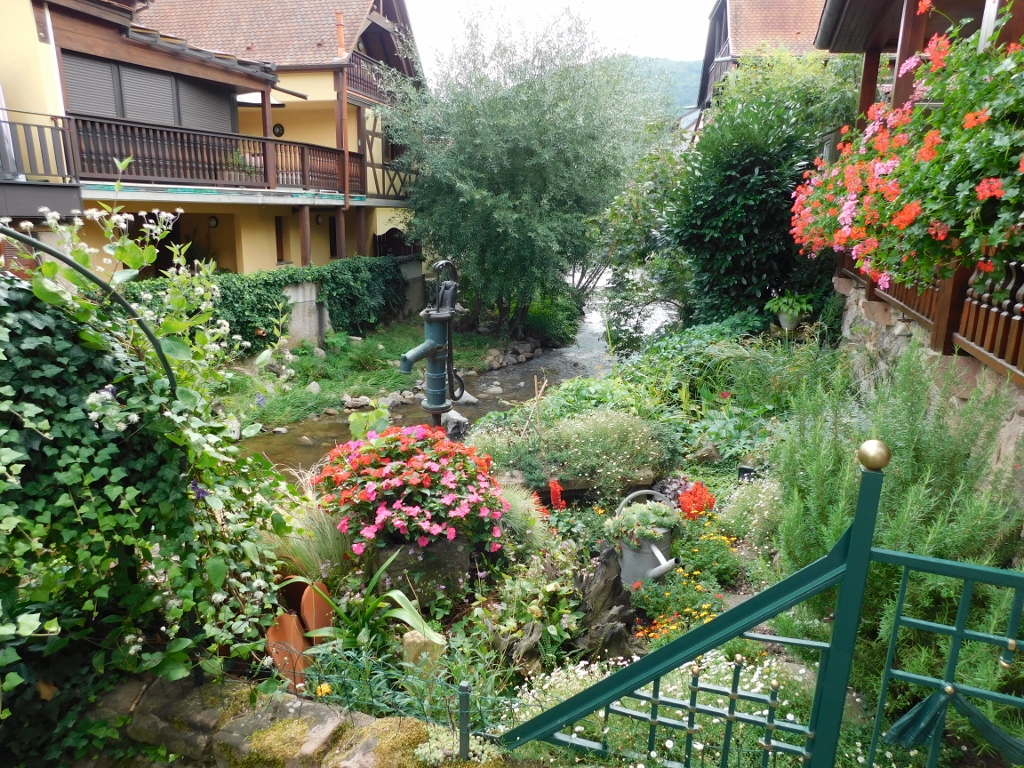 View at the Weiss
View at the Weiss
And then I reached the main street that is called Rue du Général de Gaulle. Almost the entire Kaysersberg is filled with beautiful old houses that are as if from a fairy-tale by the Brothers Grimm, but some are more famous than the others. For instance, the one seen in the photo below. This is a house that is called Maison Faller Brief and it dates back to 1594. By the way, some names are French and some are German because of the historic events in this region.
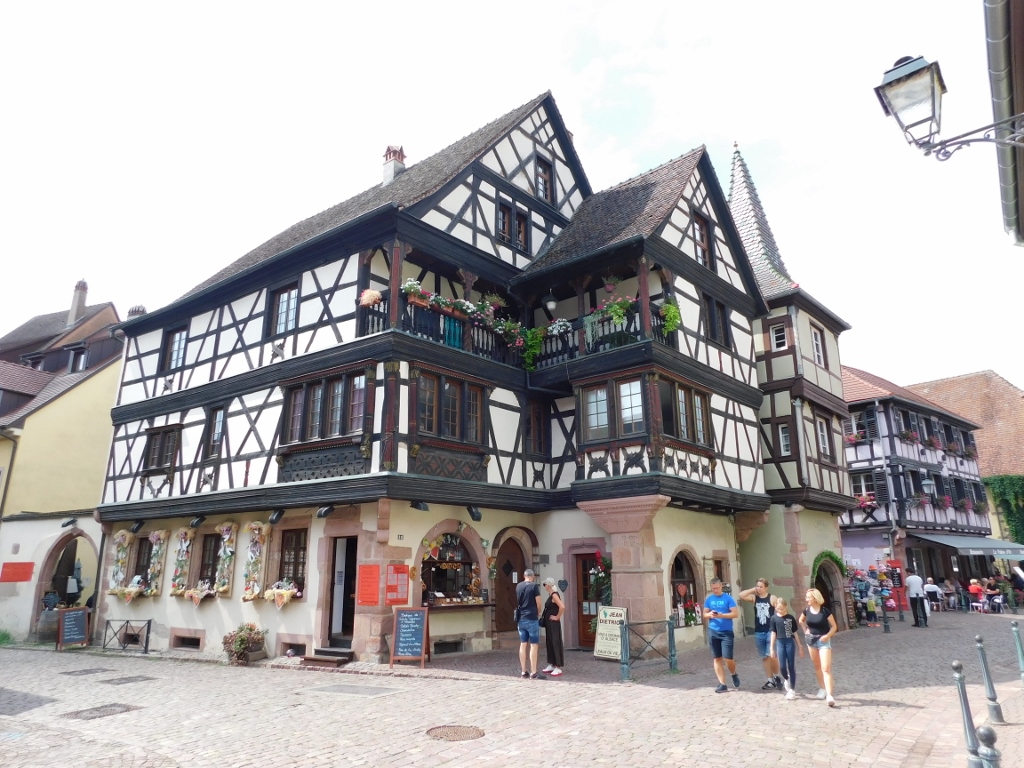 Maison Faller Brief
Maison Faller Brief
From here, I first crossed a bridge over the small Weiss river that is only 24 km long.
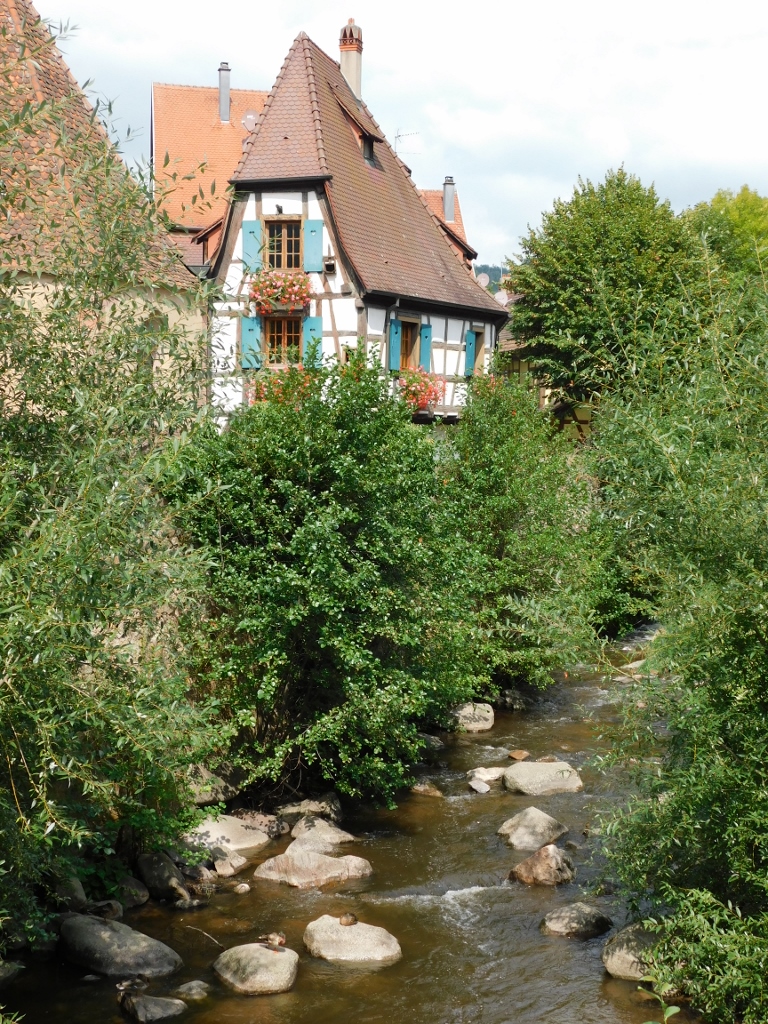 Kaysersberg
Kaysersberg
The bridge I crossed is a stone bridge from 1514 and by its elements it is unique in Alsace, primarily because it was intended to help in the defence of the town, i.e., it has features of military architecture, while also including a small oratory in its middle.
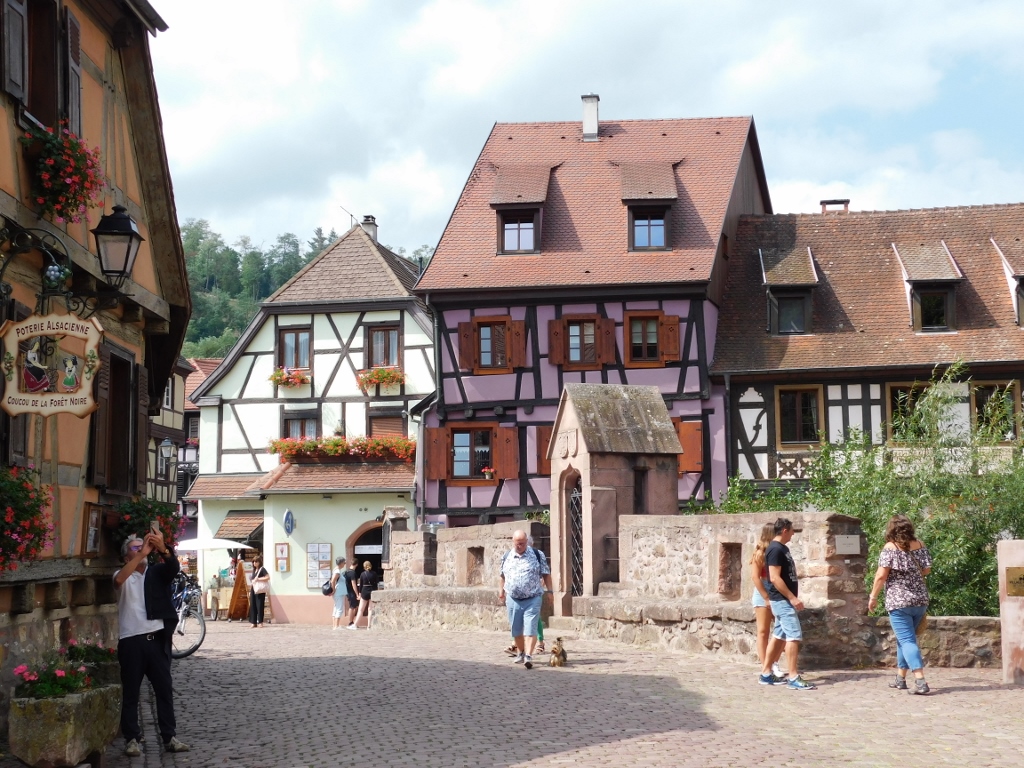 Stone bridge in Kaysersberg
Stone bridge in Kaysersberg
After the bridge, one goes directly towards Maison Herzer from 1592.
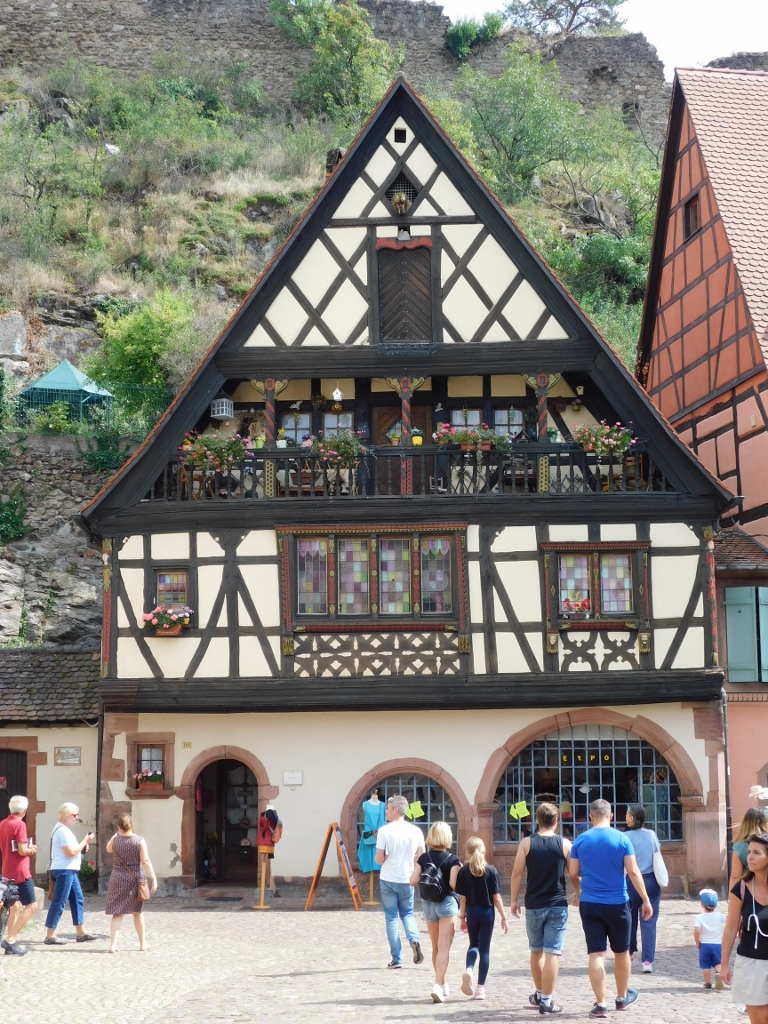 Maison Herzer
Maison Herzer
But, even when there is no official name, the vast majority of the houses are exceptionally picturesque.
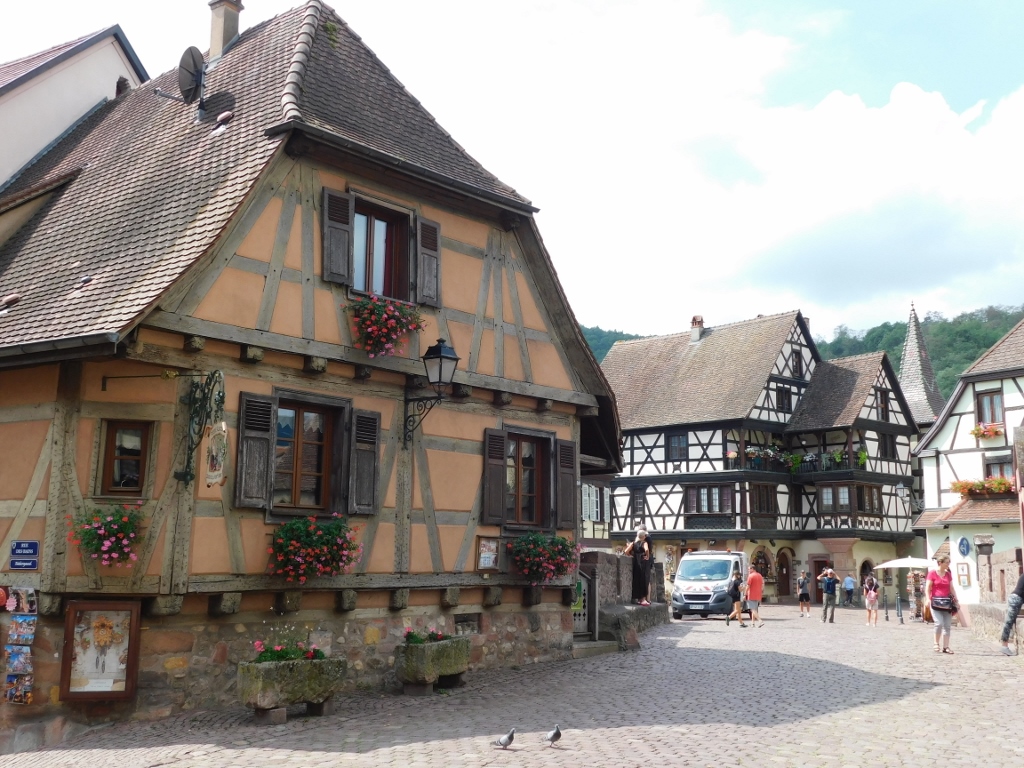 House by the stone bridge; a little farther is the Maison Faller Brief
House by the stone bridge; a little farther is the Maison Faller Brief
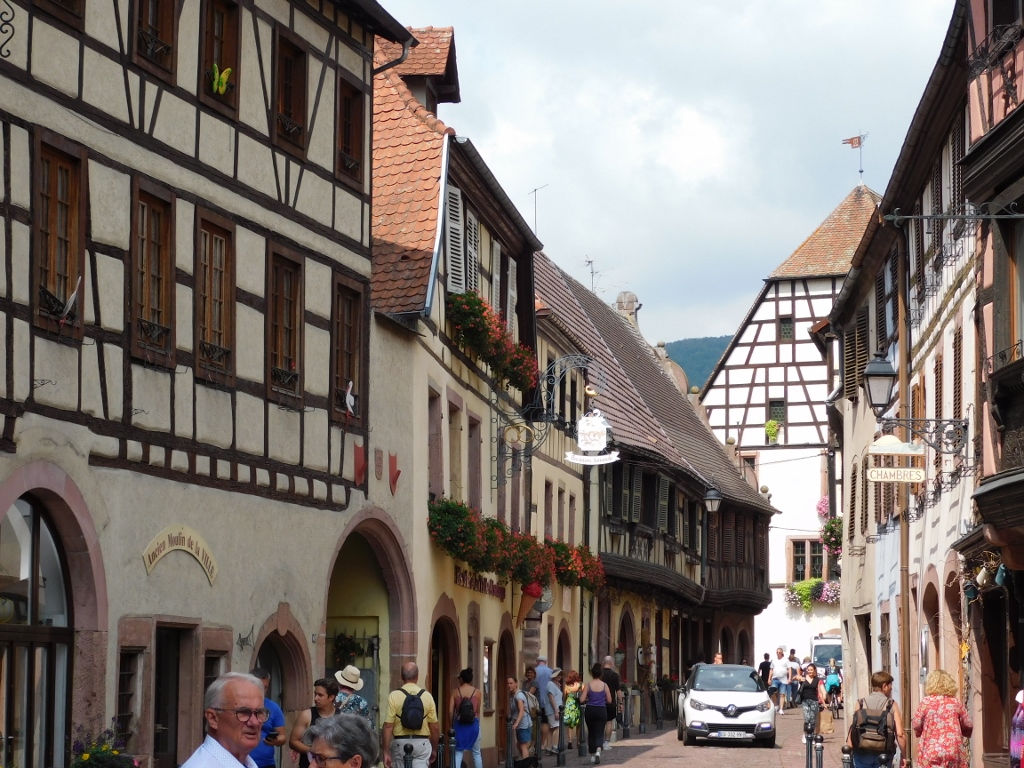 Kaysersberg
Kaysersberg
Then I reached an interesting square beside the main street. First I noted Maison Loewert from the 18th century.
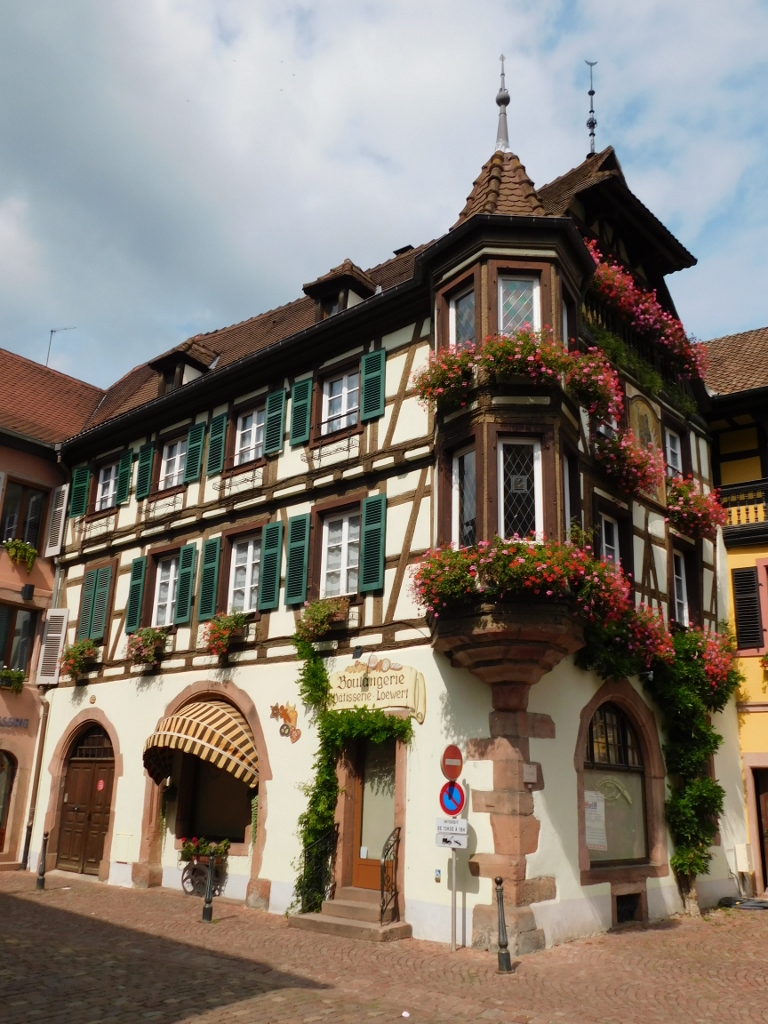 Maison Loewert
Maison Loewert
As for the house in the photo below, I could not find any data about its name or the time when it was first built, but when I looked at it I thought that this must have been the house that had been reached by Hansel and Gretel back in the day, only a town has been built around it in the meantime.
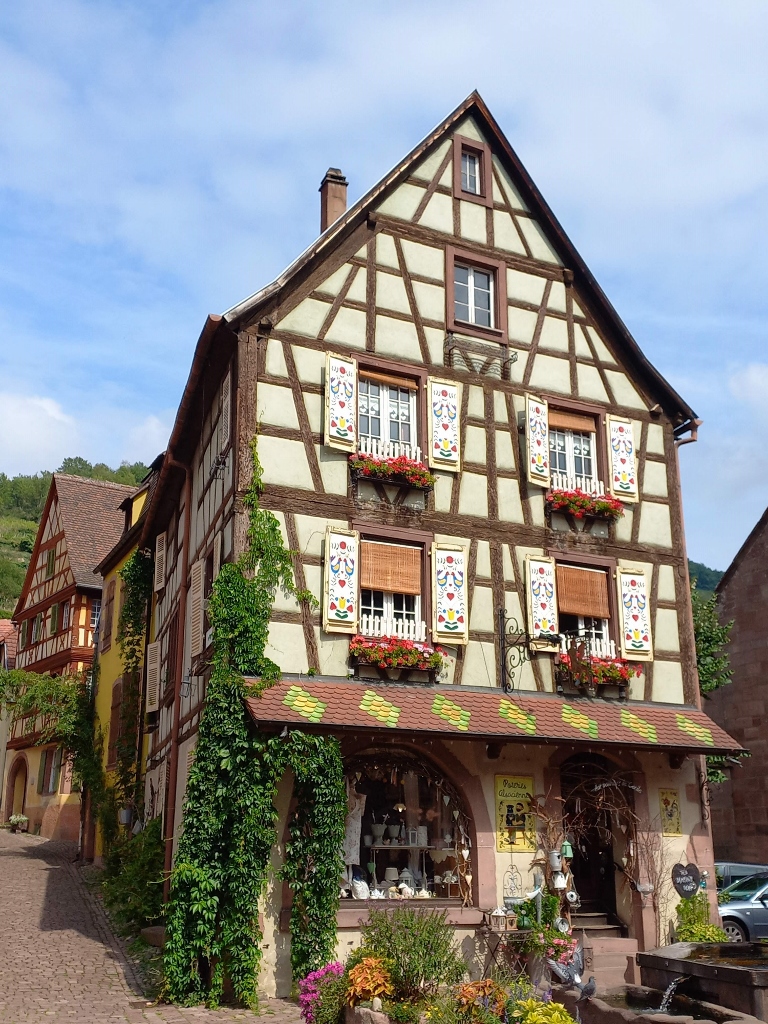 An exceptionally picturesque house in Kaysersberg
An exceptionally picturesque house in Kaysersberg
These houses I’m talking about now are located, as I’ve said, in this smallish square, Place Jean Ittel, where there is also Constantine Fountain (Fontaine de Constantin).
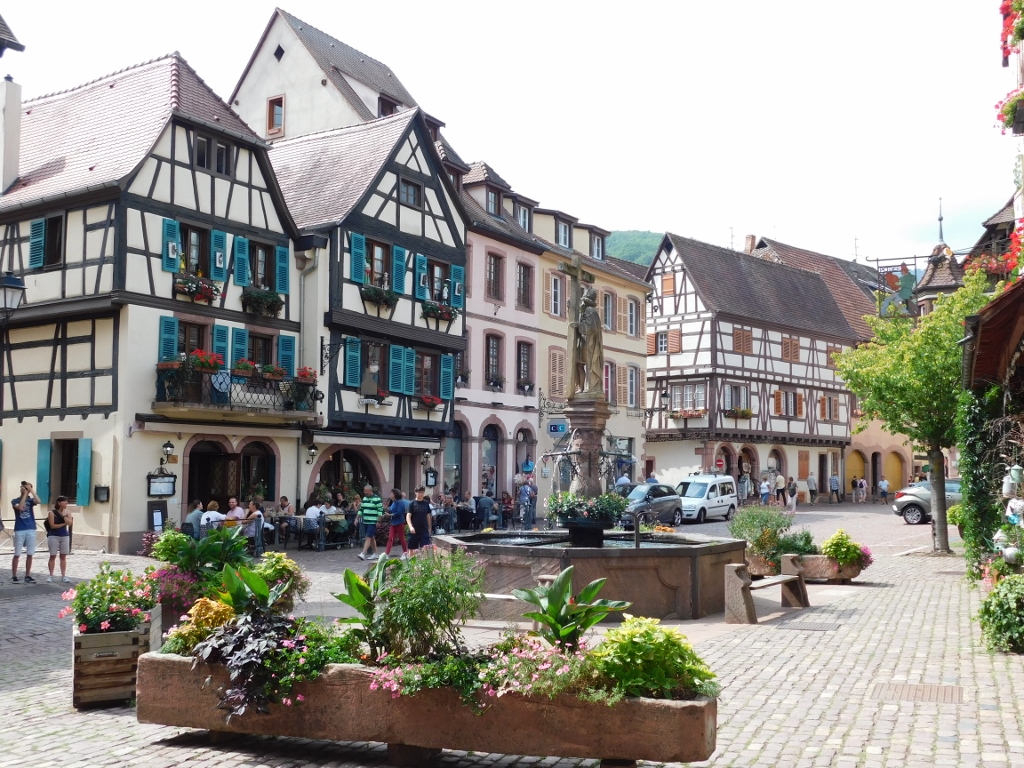 Place Jean Ittel and some details of the main street in Kaysersberg
Place Jean Ittel and some details of the main street in Kaysersberg
Right here at the square, there is also the Church of the Holy Cross (Église Sainte-Croix).
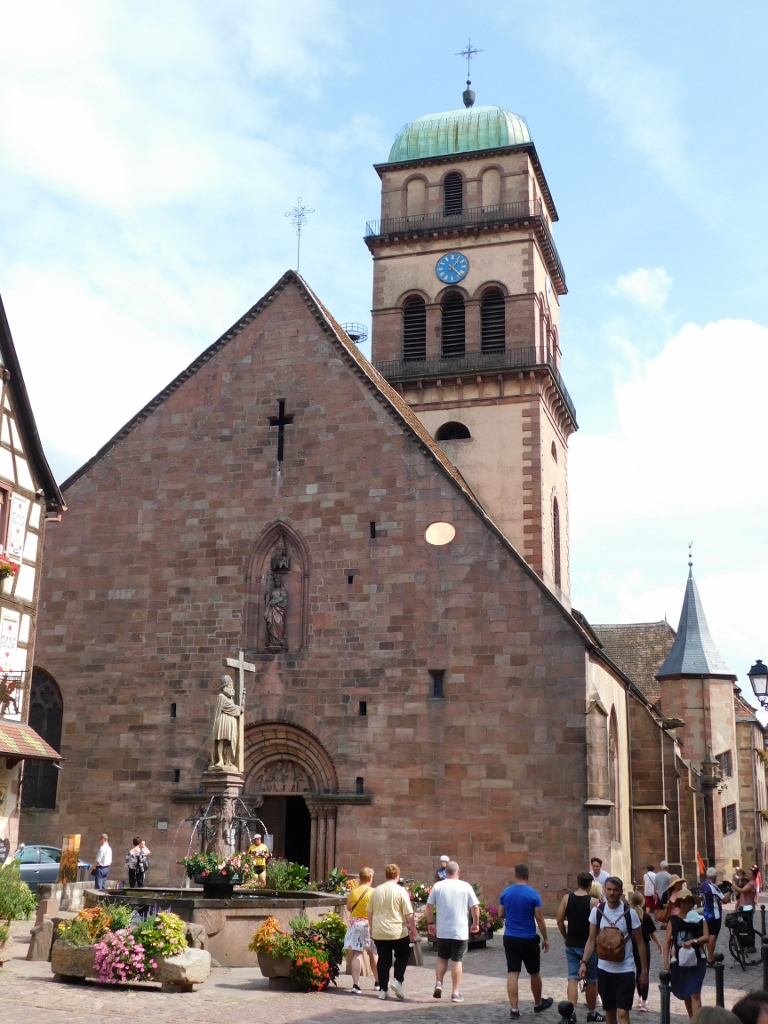 Church of the Holy Cross
Church of the Holy Cross
The church was founded in the 13th century, then it had some additions and modifications made in the 15th century, and then it eventually got its final shape in the 19th century when the dome was made on the top of the tower. Various important elements may be seen inside, but the 1518 altar is the one mentioned most often.
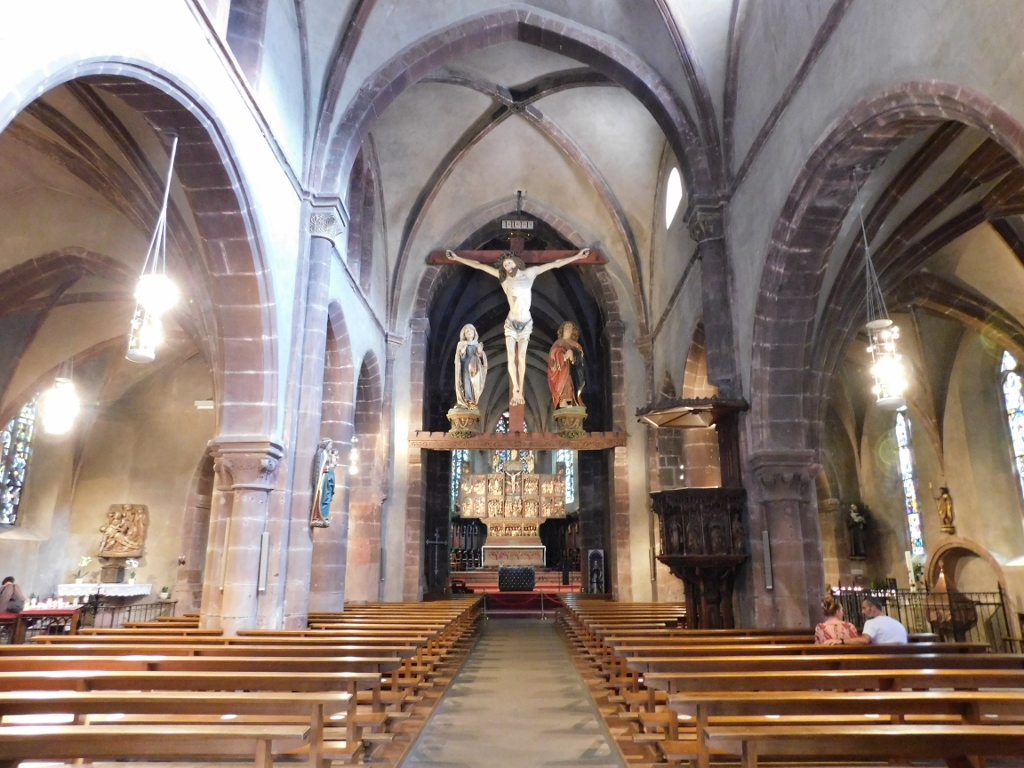 Church of the Holy Cross, the interior
Church of the Holy Cross, the interior
Right behind the church, on the same side of the street, there is also the City Hall (Hôtel de ville) from 1521.
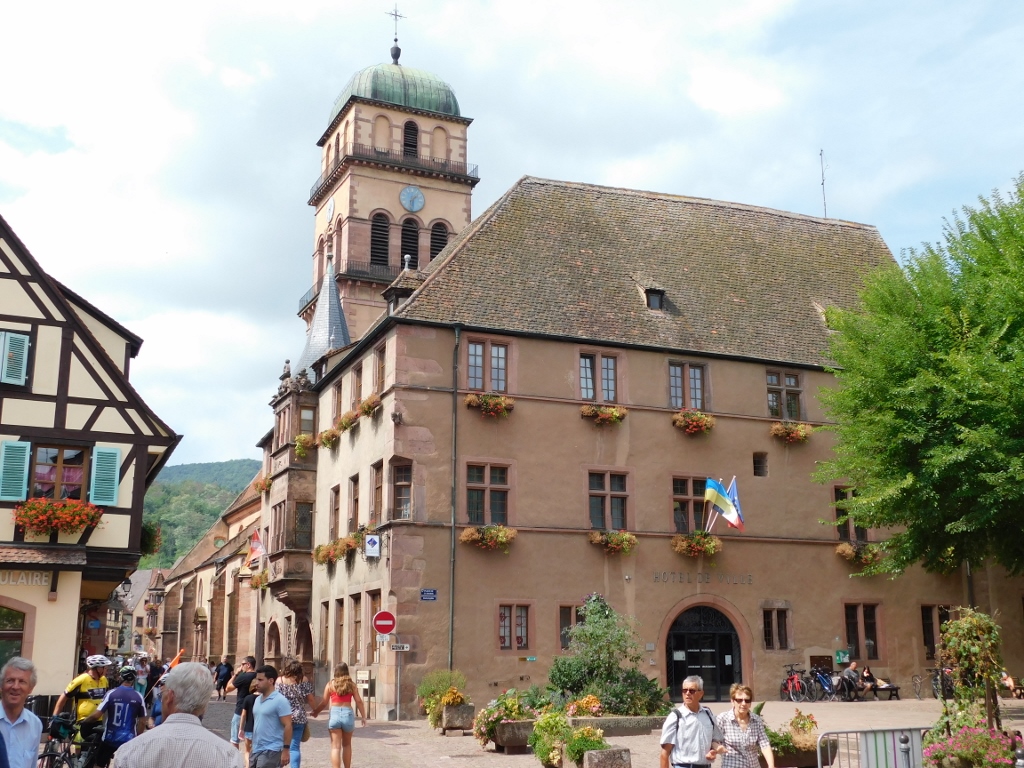 City Hall with the bell tower of the Church of the Holy Cross behind
City Hall with the bell tower of the Church of the Holy Cross behind
I continued with my walk until the end of the main street and then I simply started to return along the same way. That did not reduce the level of my enjoyment in the slightest.
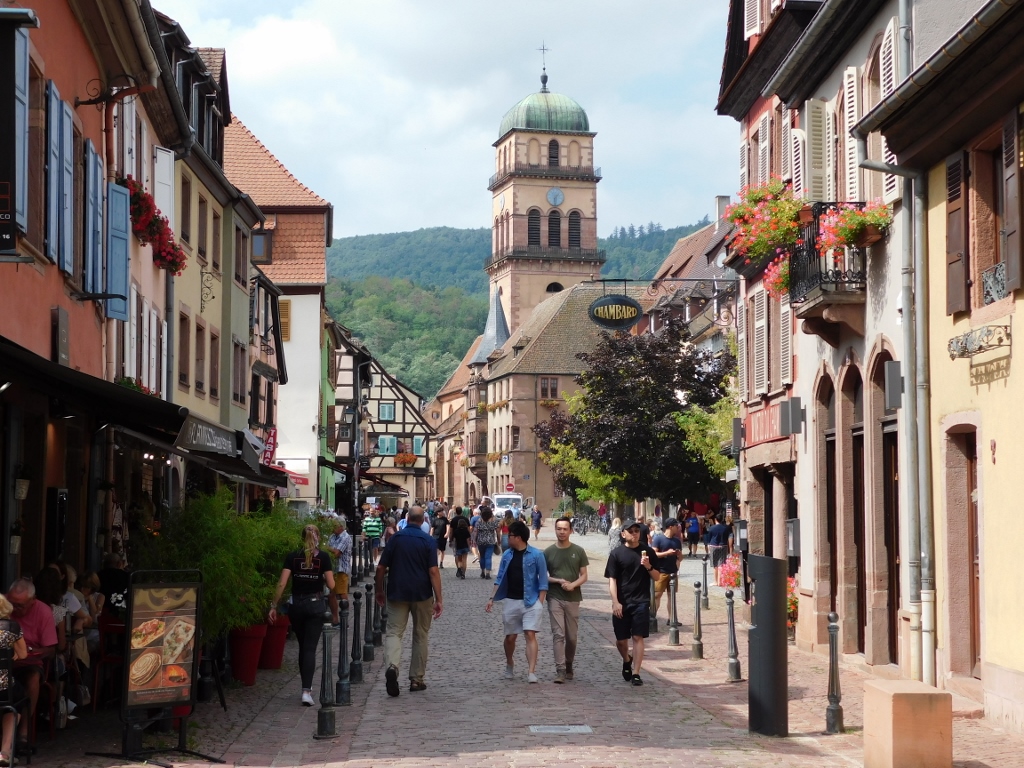 Kaysersberg
Kaysersberg
When I got back to the bridge and crossed it, instead of going along some side streets in order to get to the car, I continued along the main street up until its end. There were lots of restaurants there and I felt inspired to sit down and have a bite, but I realised I would simply not have the time. I still had two important places I wanted to visit and I had a deadline for the return of the rented car. In other words, the food was improvised on this day, mostly consisting of the biscuits I had bought earlier in Riquewihr, but I did not complain.
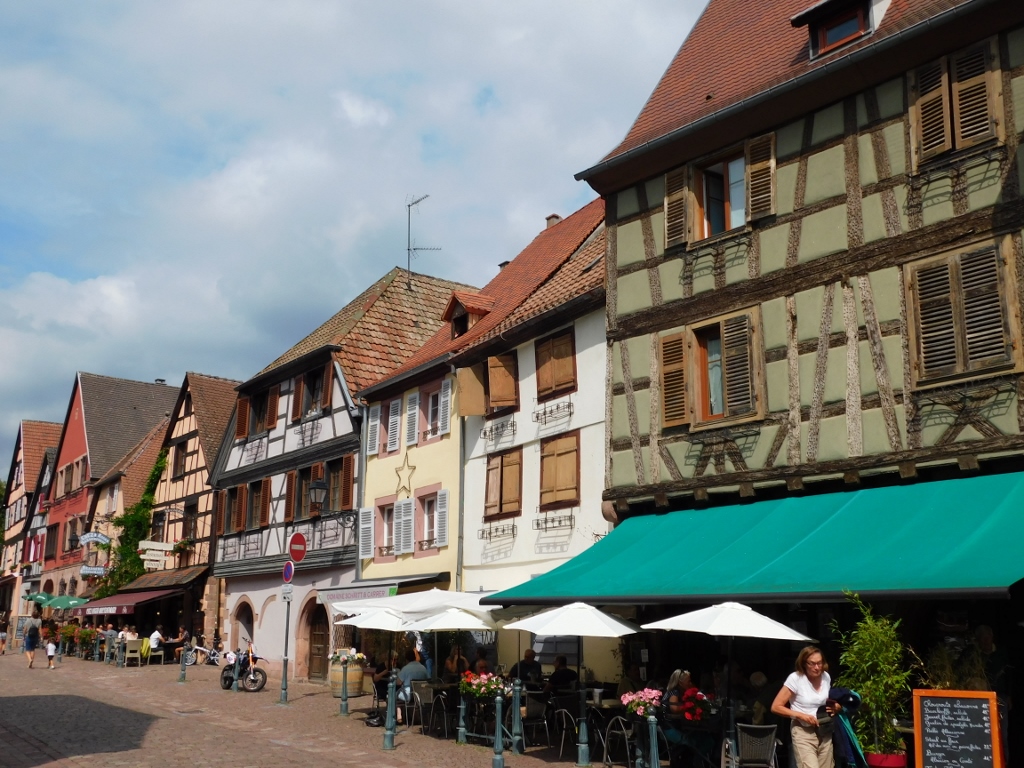 Kaysersberg
Kaysersberg
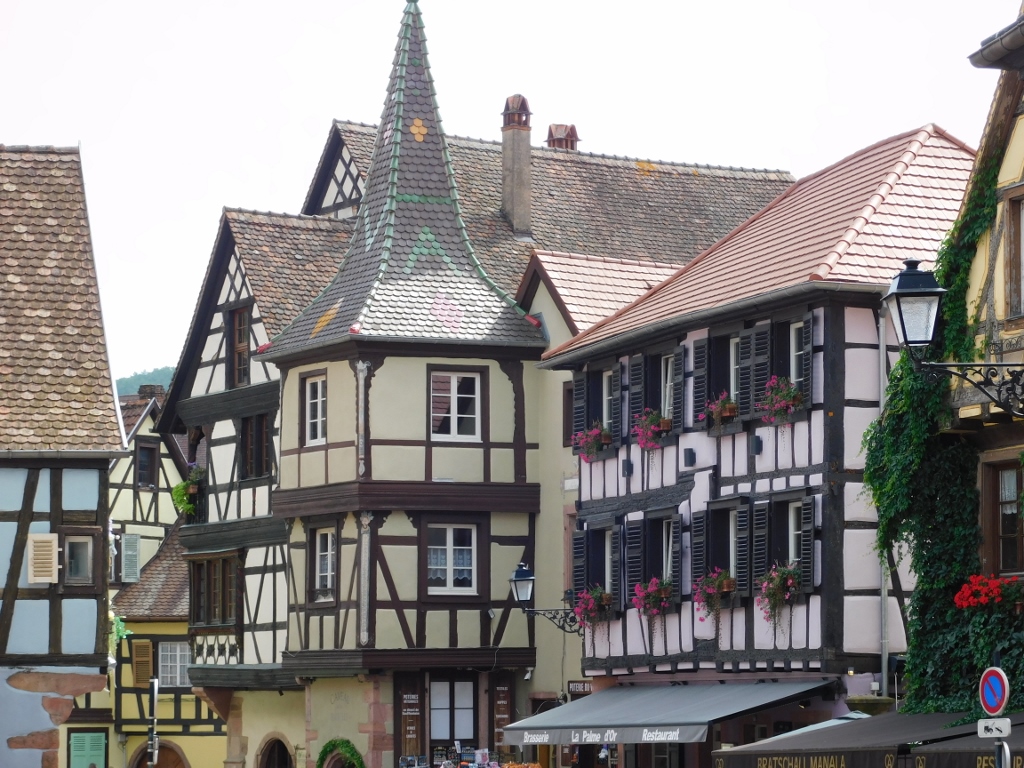 Kaysersberg
Kaysersberg
At the northwest end of the Rue du Général de Gaulle, there is the Albert Schweitzer Museum (Musée Albert Schweitzer) and it is located in the house in which this famous physician and theologian, the 1952 Nobel Peace Prize laureate, was born in 1875. I did not go here either, for the lack of time, but rather opted to walk around the remains of the ramparts that surround the centre of the town, heading for the parking lot and the car.
But, before I leave Kaysersberg with my story, let me mention one other piece of data that can probably be qualified as trivial and yet this data reflects so well the times in which I’m living and writing. It is linked to the death of a chef. Namely, the famous chef, book and TV author, Anthony Bourdain, who suffered from depression, ended his life by hanging himself in his hotel room right here, in Kaysersberg. Sad. I’m primarily thinking of the depression, the illness he suffered from.
As for me, I got into the car and drove some 40 km farther to Murbach Abbey (Abbaye de Murbach).
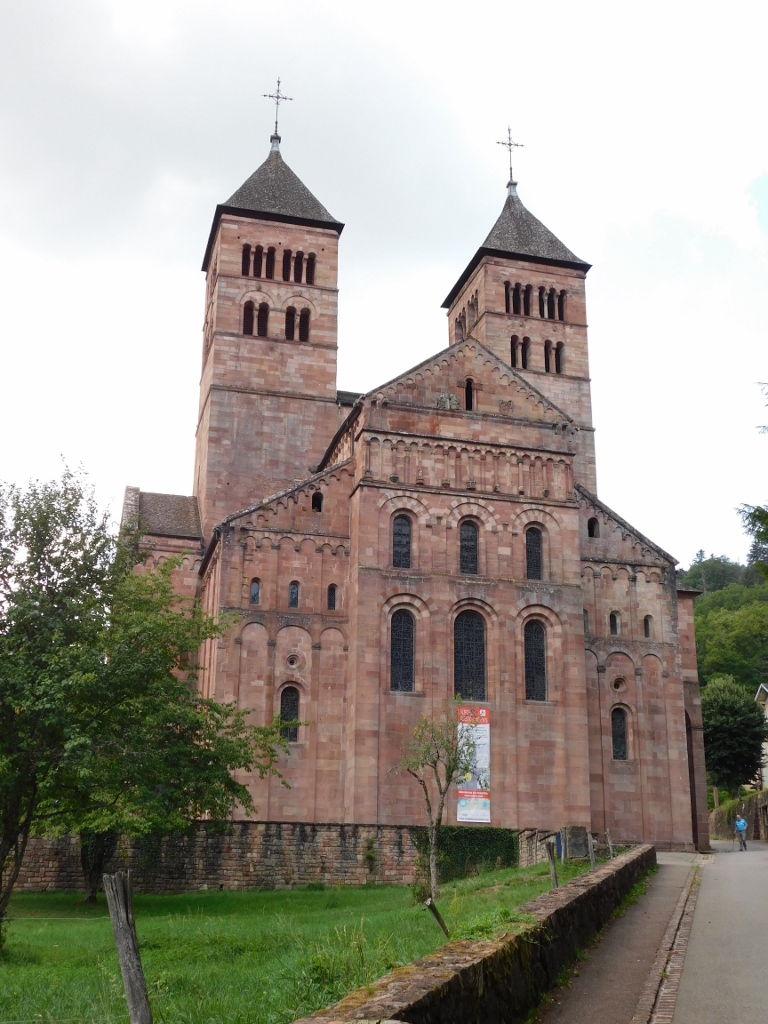 Murbach Abbey
Murbach Abbey
This Benedictine abbey was founded in 728 and its Romanesque church, one of the most beautiful in Alsace, was built in 1145. The church is dedicated to Saint Leodegar (St. Léger). It is also interesting that this abbey was the owner of a Benedictine monastery founded around 750 in the place that would later become the town of Lucerne in Switzerland. The town of Lucerne was formally founded in 1178 and here at the abbey in Murbach it is possible to see a plaque saying that the town was founded precisely by this abbey.
As I was approaching the church I was quite taken by its imposing size that was even more pronounced since the church was built in a rather narrow valley and this disproportion seemed truly impressive. But, the main surprise followed when I entered the church.
Namely, in 1789, during the French Revolution, the local population laid both the abbey and the church to waste and this marked the end of this institution. Since then, only the front part of the church (the transept) has survived and I presume it was “closed” from the back at some point in time, while the area where the nave used to be was turned into a cemetery over time. All of this becomes much clearer when one enters the church and later walks around it. As the things are today, the church is practically significantly broader than it is long and this is exceptionally unusual.
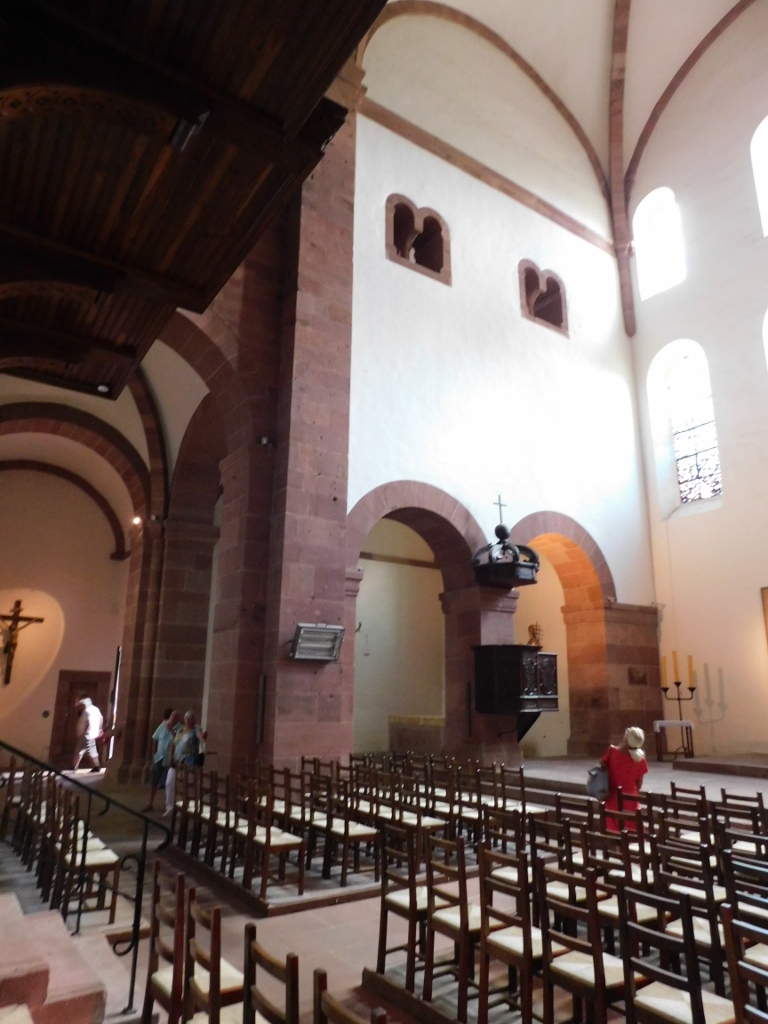 Murbach Church, this is the entire “length” of the church
Murbach Church, this is the entire “length” of the church
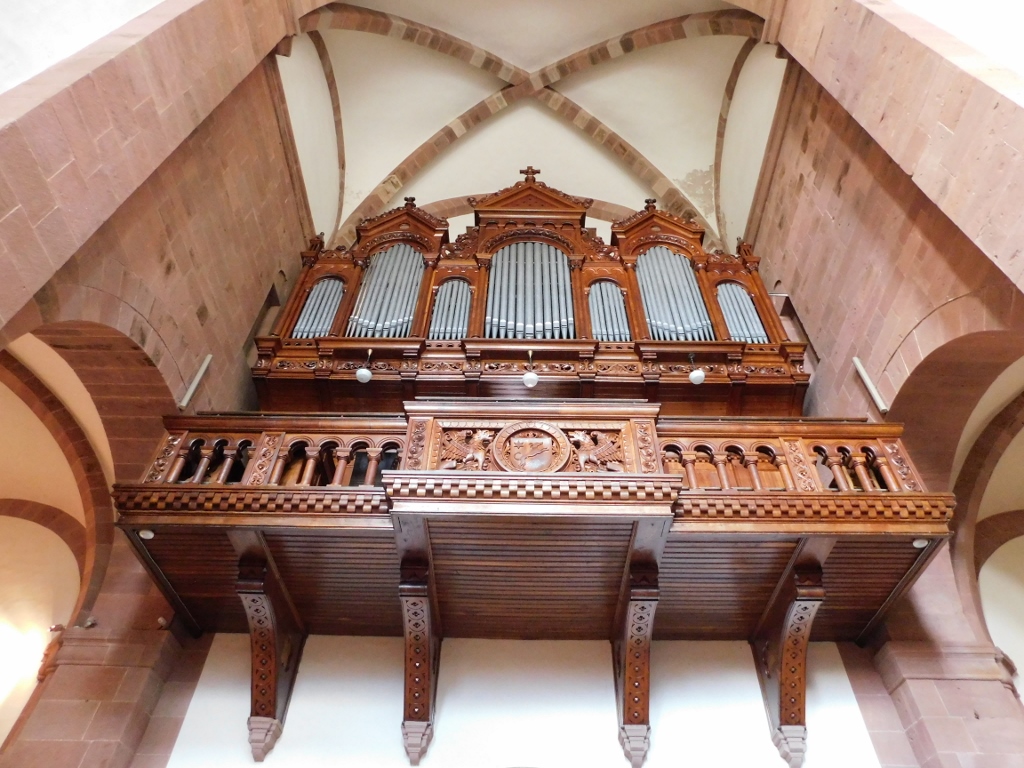 Murbach Church, a detail
Murbach Church, a detail
Here is also a video-clip that illustrates this unusual space even better.
When I got out, I went to the back section and there it is possible to see the present-day cemetery, while this was where the nave of the church used to be.
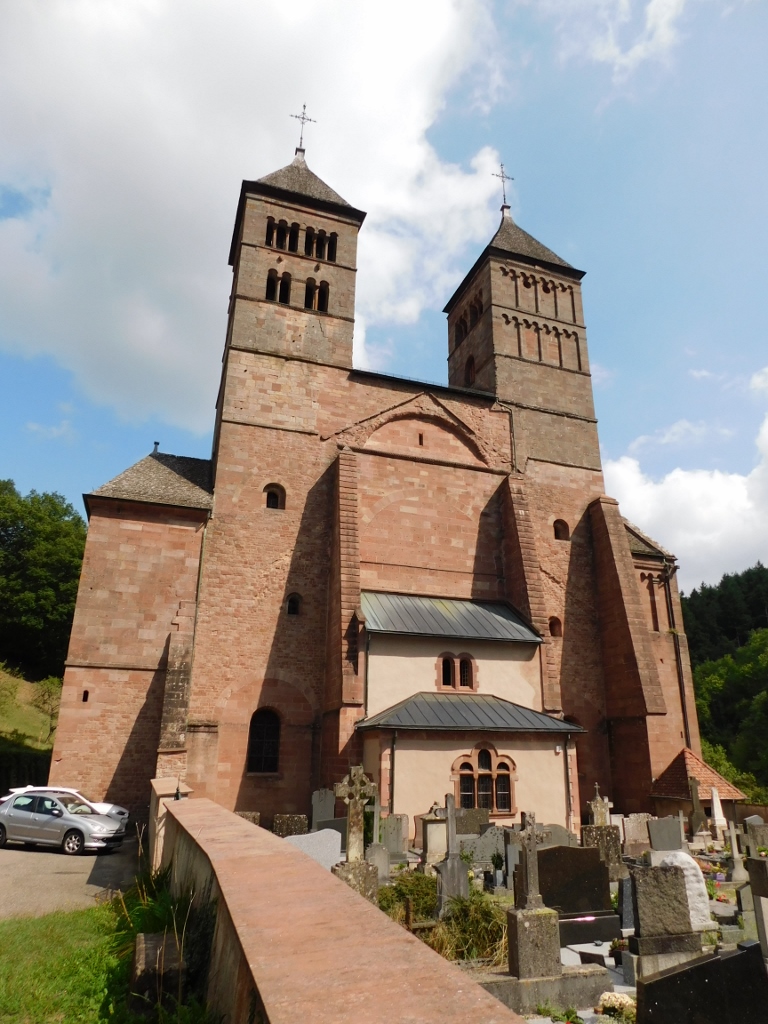 Murbach Church
Murbach Church
Here I focused a little more on the surroundings again. As I’ve mentioned, I found the size of the church, even this “downsized” version of the church, in disproportion relative to the space around it, but the nature was certainly most beautiful.
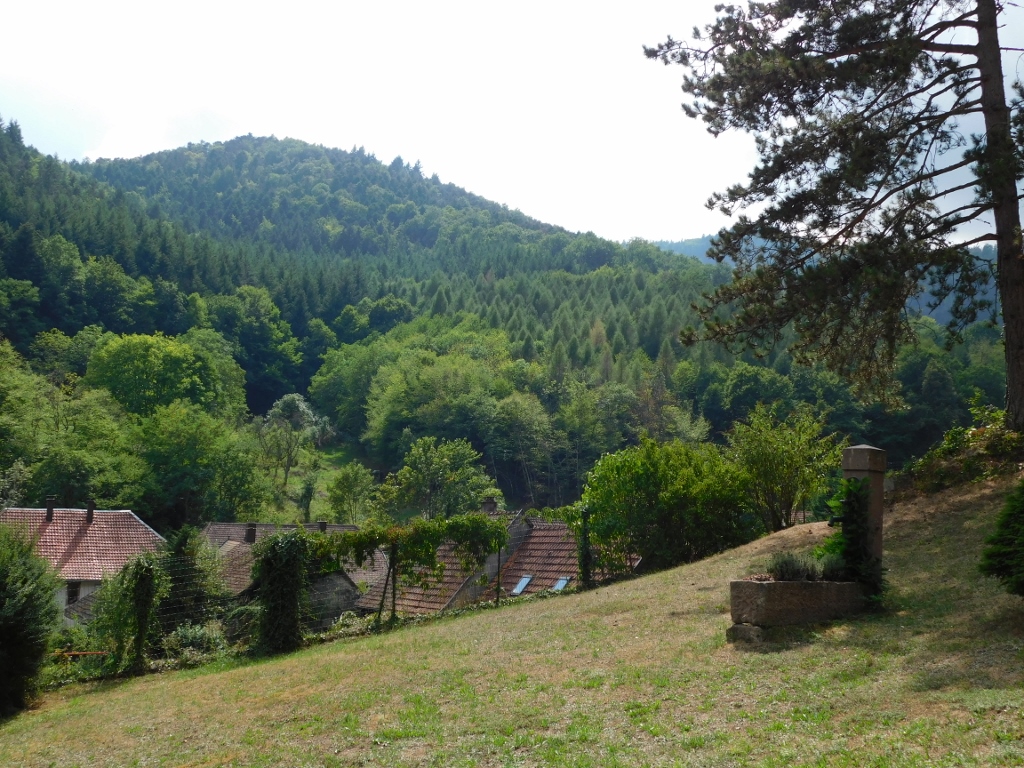 Surroundings of Murbach Church
Surroundings of Murbach Church
I started to walk around a little, pondering whether I should walk to a nearby small chapel dedicated to the Mother of God, but in the end I gave up on this idea since the time when I was supposed to return the rented car was getting seriously close and I still had one more important and absolutely unavoidable destination left. Still, I took the advantage of the fact that I climbed up a little in order to take one more photo of the church. The photo below illustrates even better how “short” the church actually is.
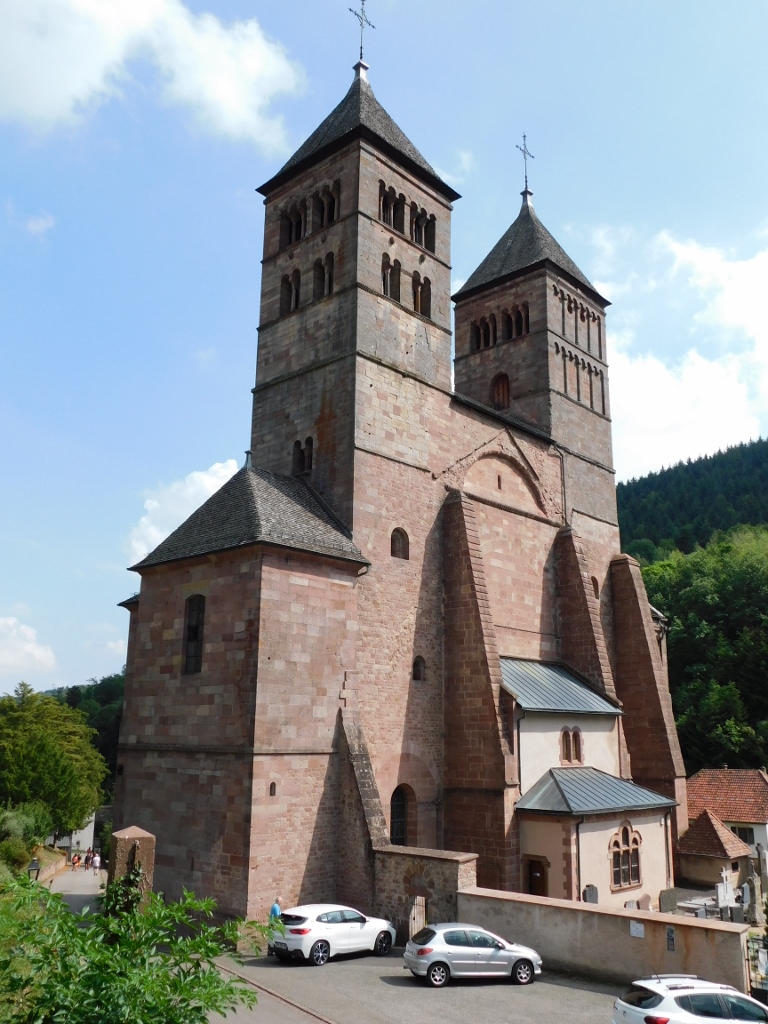 Murbach Church
Murbach Church
On my way back to the car I walked through a garden that belongs to the abbey and there I saw some people enjoying one another’s company.
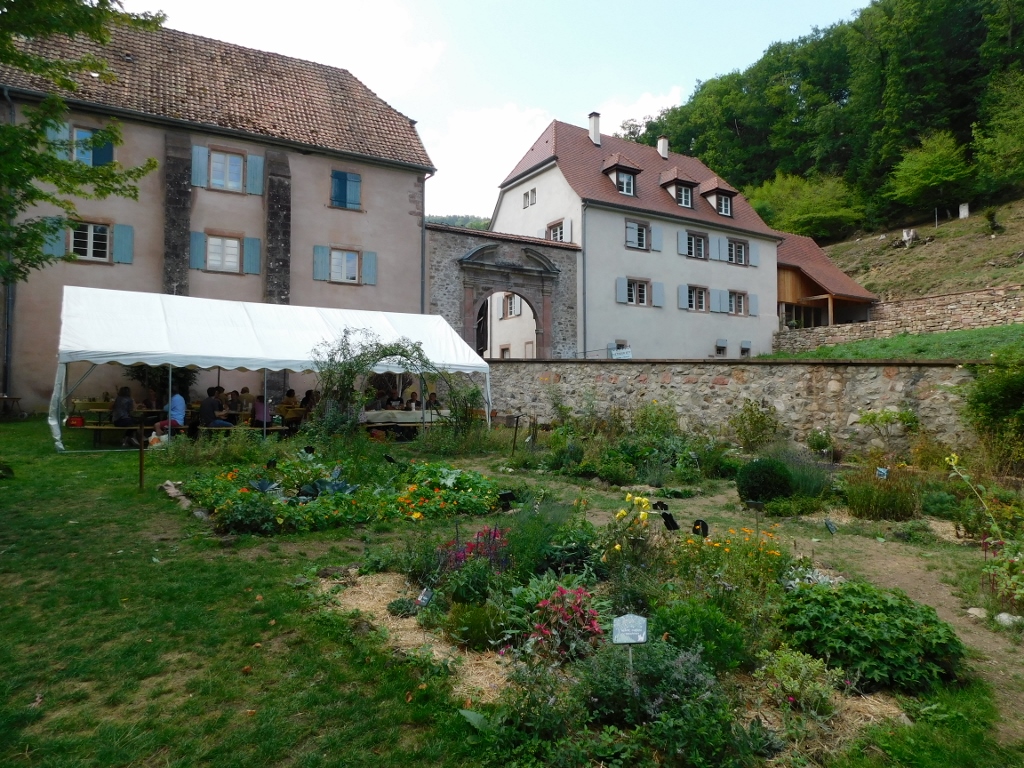 Murbach Abbey garden
Murbach Abbey garden
I did not even think of joining in, but I hastily headed for Ronchamp, which was some 90 km farther away. Using the navigation device I had in the car I selected the fastest route and this also included a drive on a motorway. This was not a bad solution at all, since I could drive a little faster, so I did reach nicely both Ronchamp and the hillock above the village with the famous chapel. I bought an entrance ticket and soon I got to a spot from which I could take a fine photo of the Chapel of Notre-Dame-du-Haut in Ronchamp.
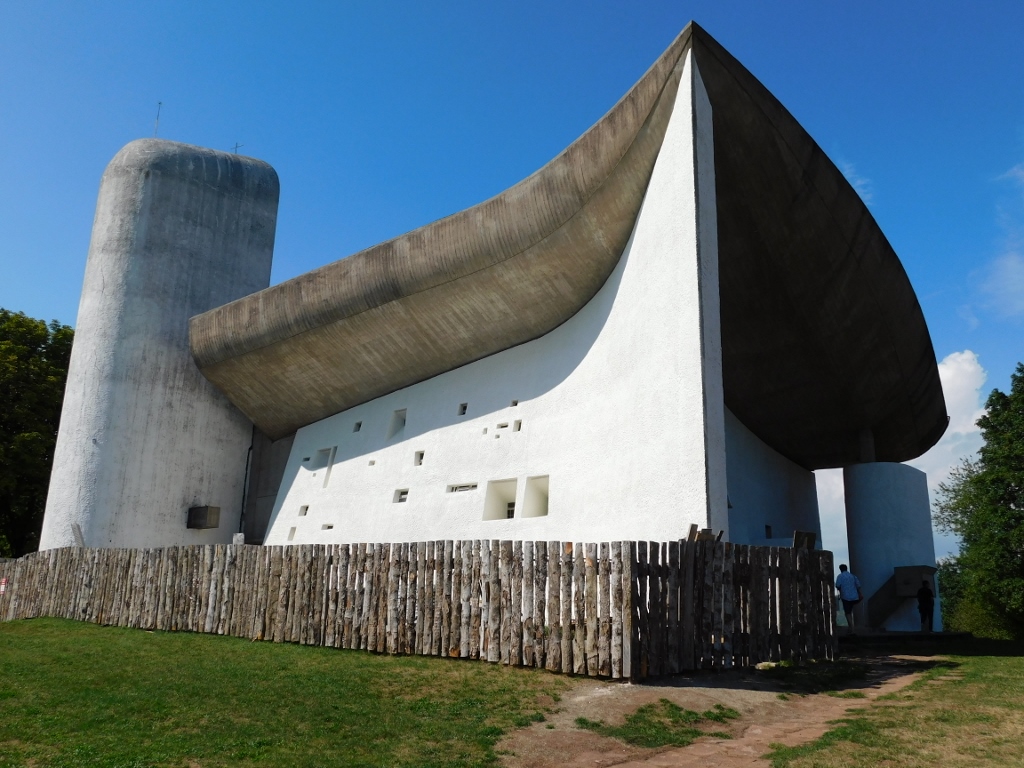 Chapel of Ronchamp
Chapel of Ronchamp
This chapel of unusual appearance is a masterpiece by the famous modernistic architect Charles-Édouard Jeanneret-Gris, better known as Le Corbusieu (1887-1965), who was born in Switzerland, but who became a French citizen in 1930. I have already mentioned him before in my travelogues – when I wrote about my journey in Brazil, where there is a building in Rio de Janeiro which he designed (https://www.svudapodji.com/en/brazil-2/), as well as when I wrote about my visit to the French Riviera where Le Corbusieu had his summer home and where he passed away (https://www.svudapodji.com/en/french-riviera-4/). As a renowned architect, he did various projects on different continents, but one of his most famous projects is precisely this chapel that can be seen on a hillock above the village of Ronchamp.
There used to be a chapel at this site earlier (the original chapel was built already in the 4th century), but it was completely destroyed during WWII. In 1950, it was proposed to Le Corbusieu that he designed a new chapel. He came here first in order to see the landscape and soon the first sketches were ready. The structure looked like anything else, but a church, at least the type of church that used to be built until then. Even Le Corbusieu himself was fully aware of the large degree to which his design deviated from the usual models, but luckily there was the archbishop of Besançon around who did not mind the proposed extreme appearance of the new church and who, together with a commission, approved the project. The result has, I believe, surpassed the expectations of all – ever since its construction (it was built from 1950 to 1954, while it was consecrated in 1955) this building made of concrete has been considered one of the most influential buildings in modern architecture.
I will not go now into comprehensive describing of the church or various details linked to it, since a lot of information about it can be found on the internet, but rather I will only provide some general information and will sporadically explain what can be seen in the photos. To start with, here is the whole church again, but from a slightly different angle, so that its “front” facade and the entrance can also be seen.
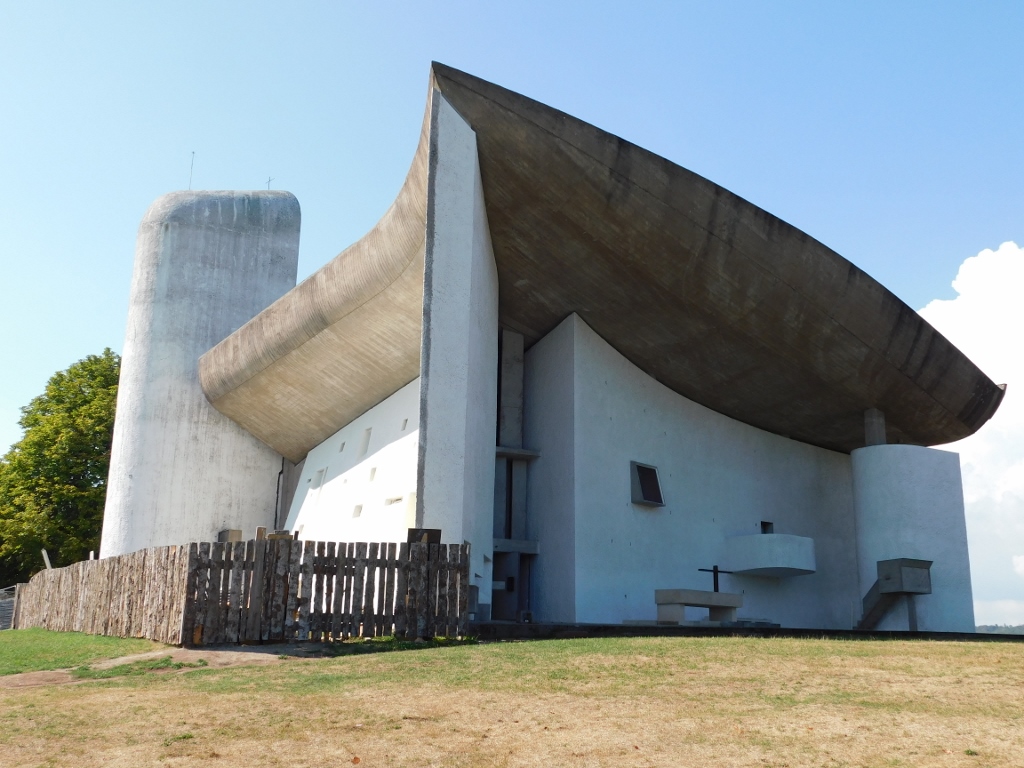 Chapel of Ronchamp: the “front” facade is in the shade
Chapel of Ronchamp: the “front” facade is in the shade
The church is actually rather small and the dimensions of its nave are 24 x 15 m, which means that only a little over 200 people may fit in. Because of this, there is an altar and a pulpit on the outside as well, so it is possible to organise open-air masses. In the photo above, these elements can be seen on the “front” facade.
Here is also a photograph that shows the entrance into the chapel.
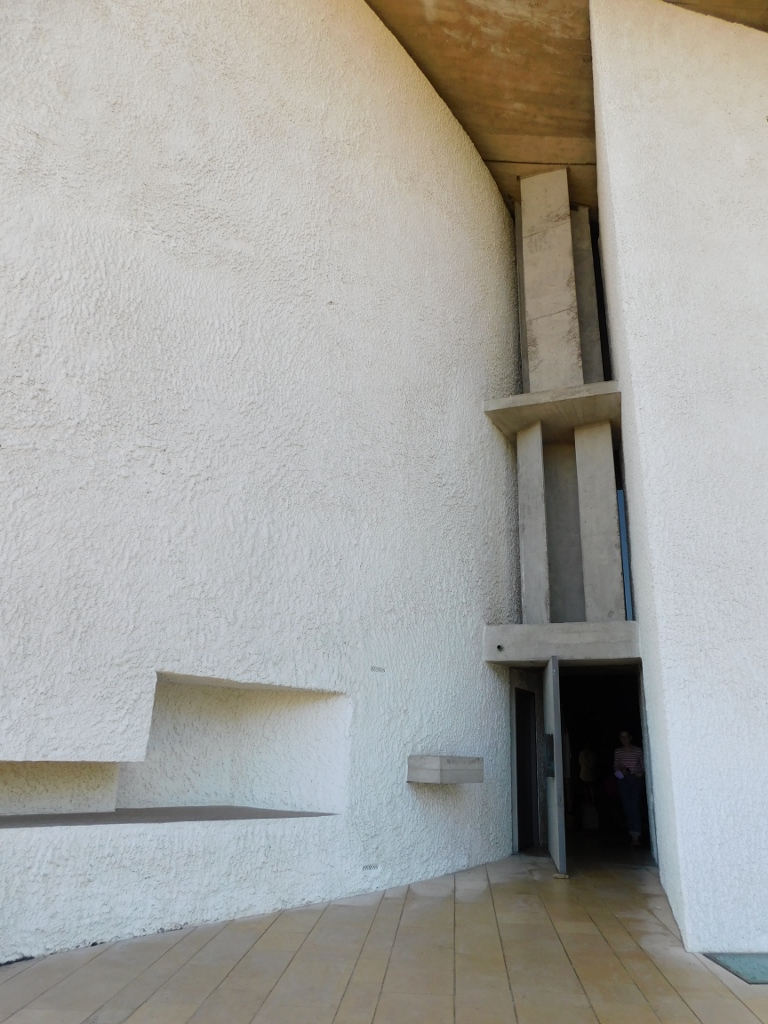 Chapel of Ronchamp: the entrance
Chapel of Ronchamp: the entrance
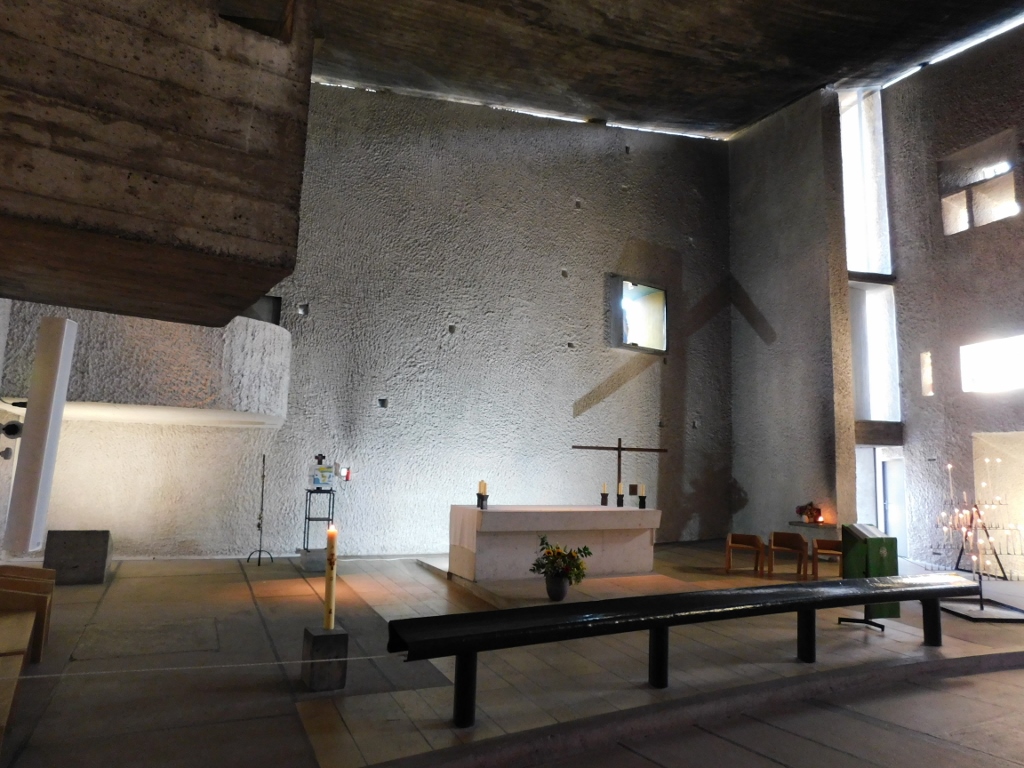 Chapel of Ronchamp: the interior altar, while the entrance is to the right and practically beside the altar
Chapel of Ronchamp: the interior altar, while the entrance is to the right and practically beside the altar
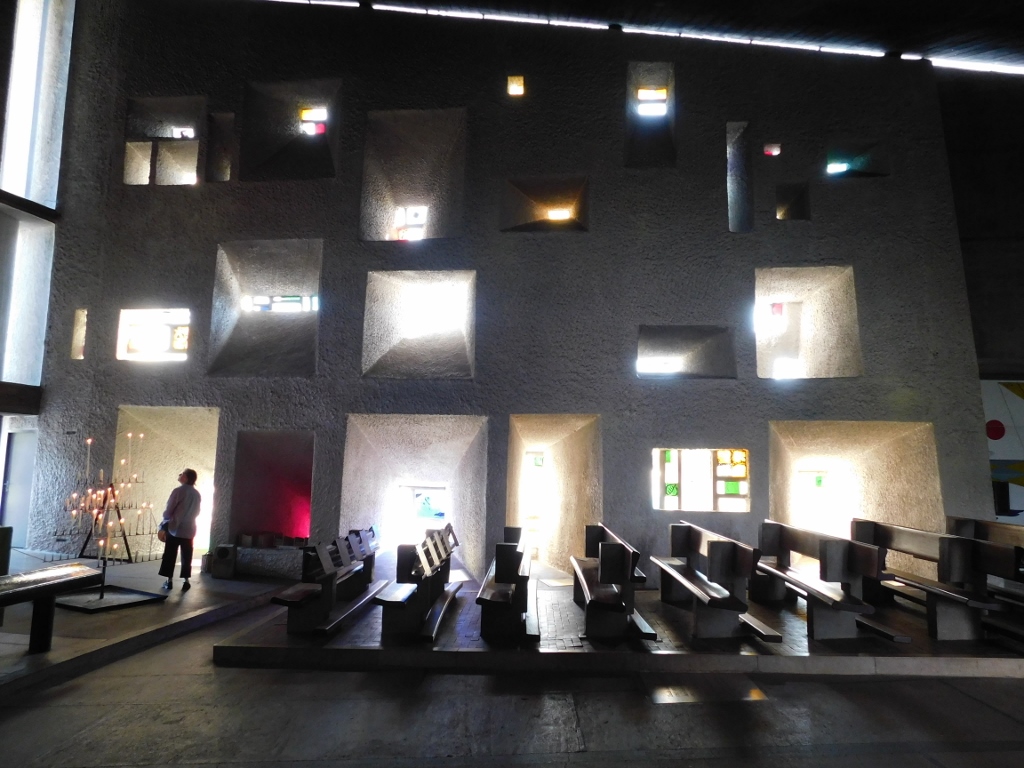 Chapel of Ronchamp: the south wall
Chapel of Ronchamp: the south wall
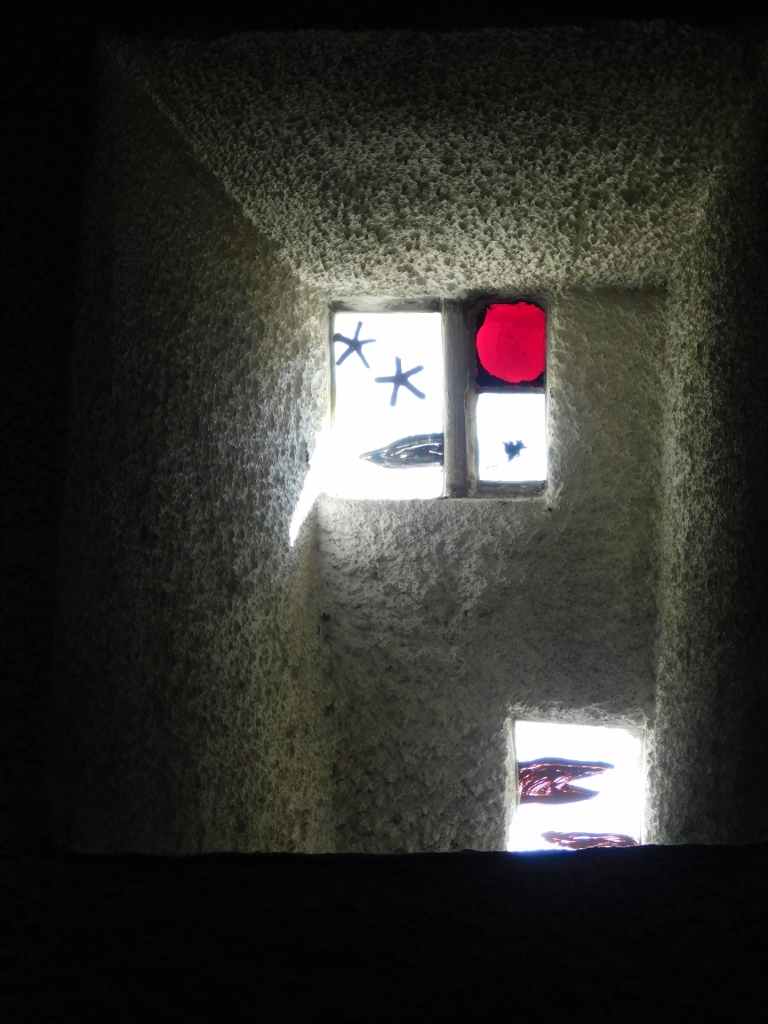 Chapel of Ronchamp: the south wall, a detail
Chapel of Ronchamp: the south wall, a detail
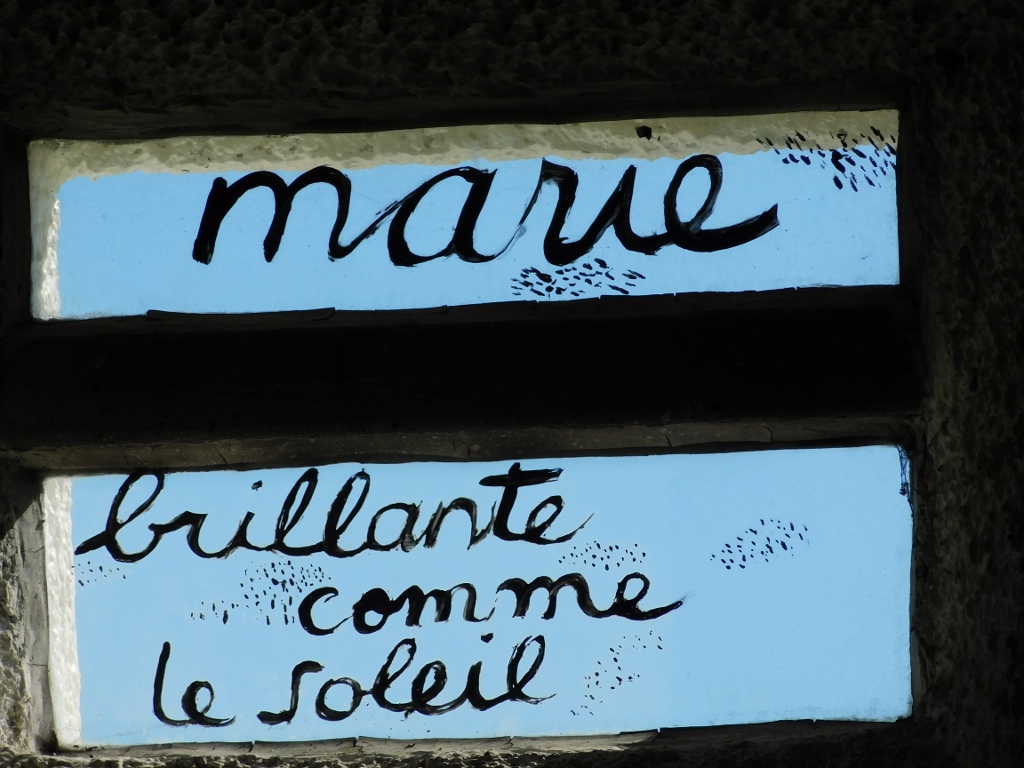 Chapel of Ronchamp: the south wall, a detail
Chapel of Ronchamp: the south wall, a detail
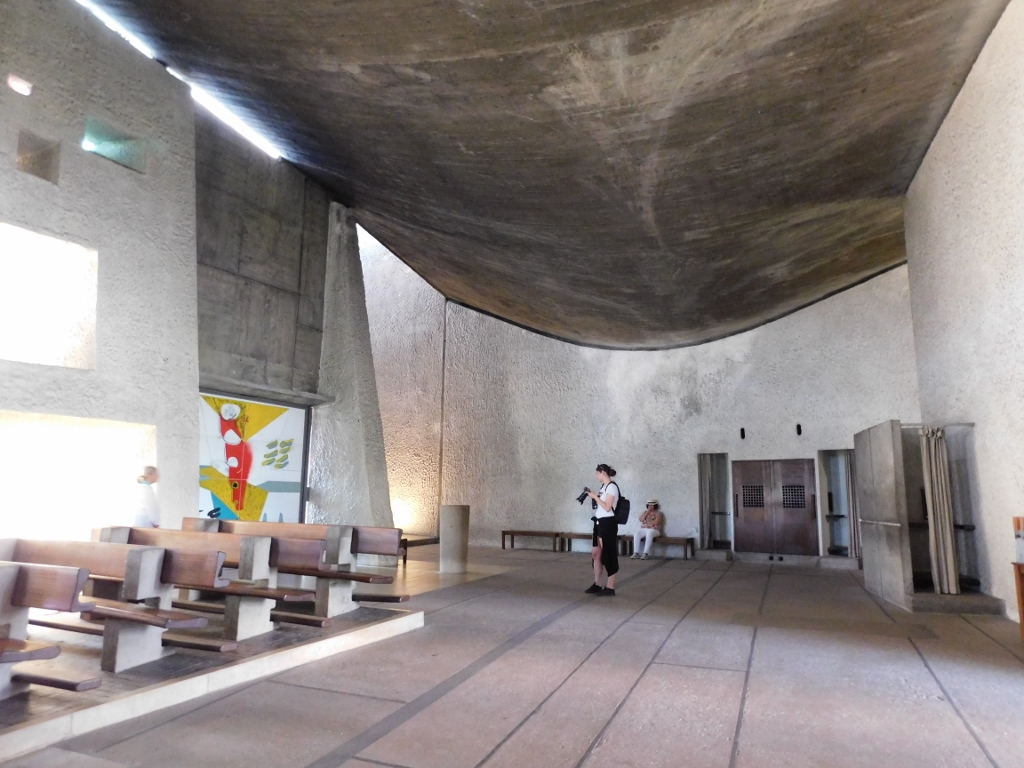 Chapel of Ronchamp: the nave of the church
Chapel of Ronchamp: the nave of the church
In the back of the nave, on the left-hand side, there is a flanking chapel/altar of a very simple shape and appearance, but I found it particularly interesting since there is structure above it in the shape of a high tower that looked like a silo to me. Le Corbusieu must have had a blast while “playing” and conceiving this whole structure and its details.
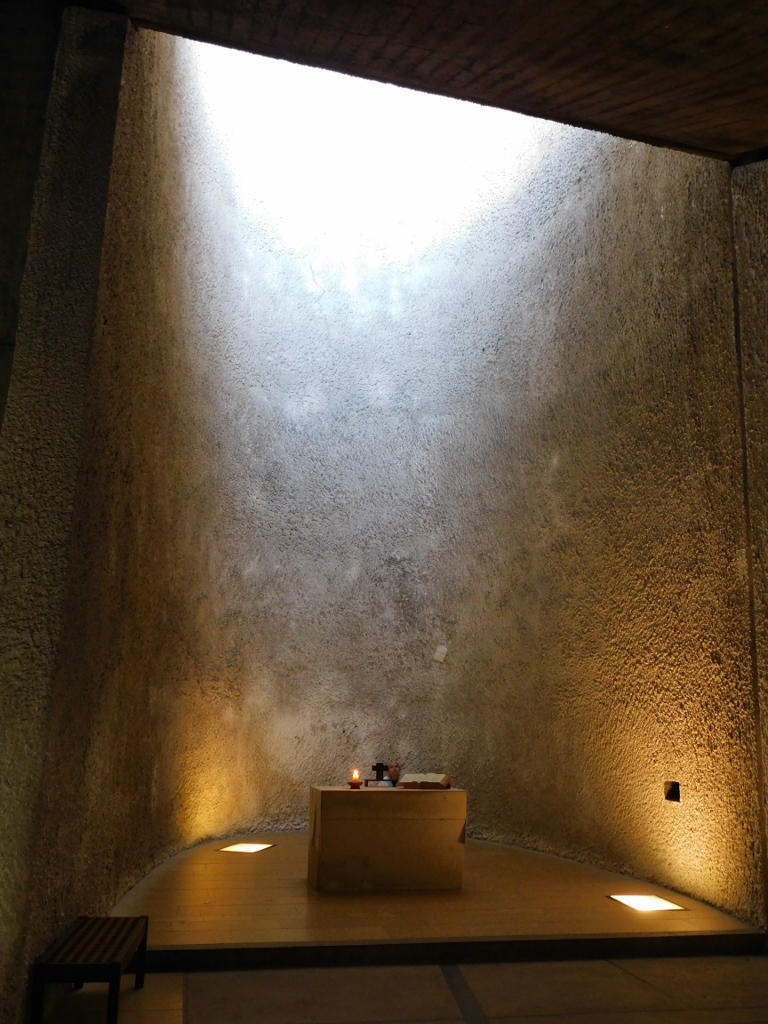 Chapel of Ronchamp: the flanking chapel
Chapel of Ronchamp: the flanking chapel
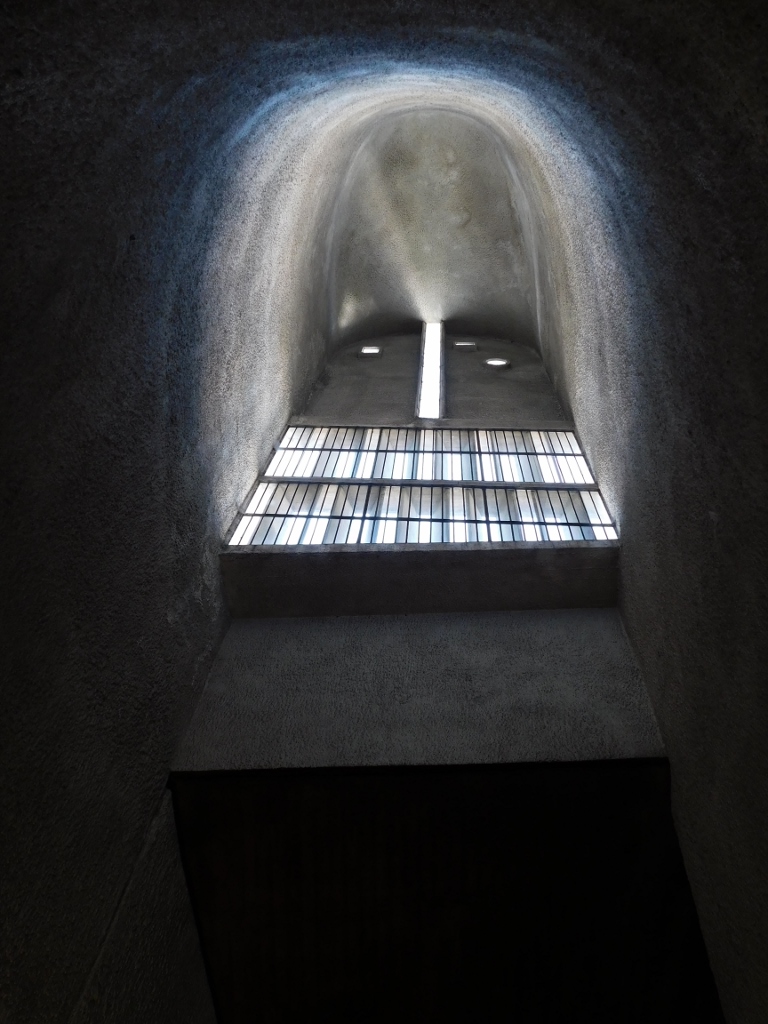 Chapel of Ronchamp: the flanking chapel
Chapel of Ronchamp: the flanking chapel
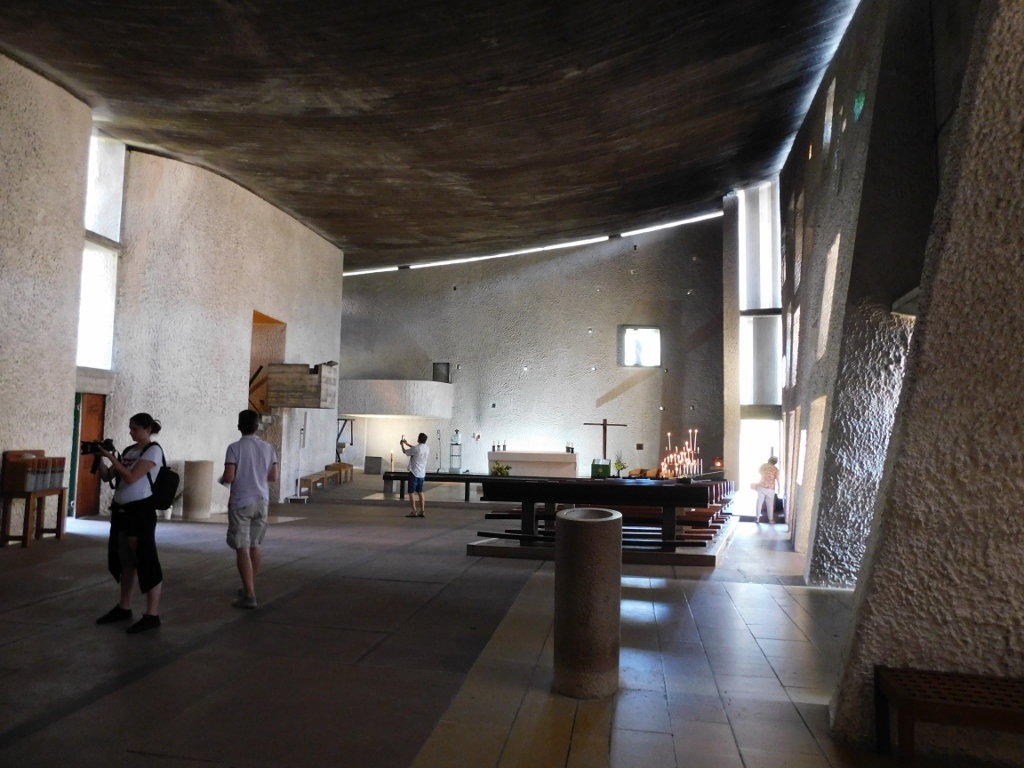 Chapel of Ronchamp: view at the nave and the altar
Chapel of Ronchamp: view at the nave and the altar
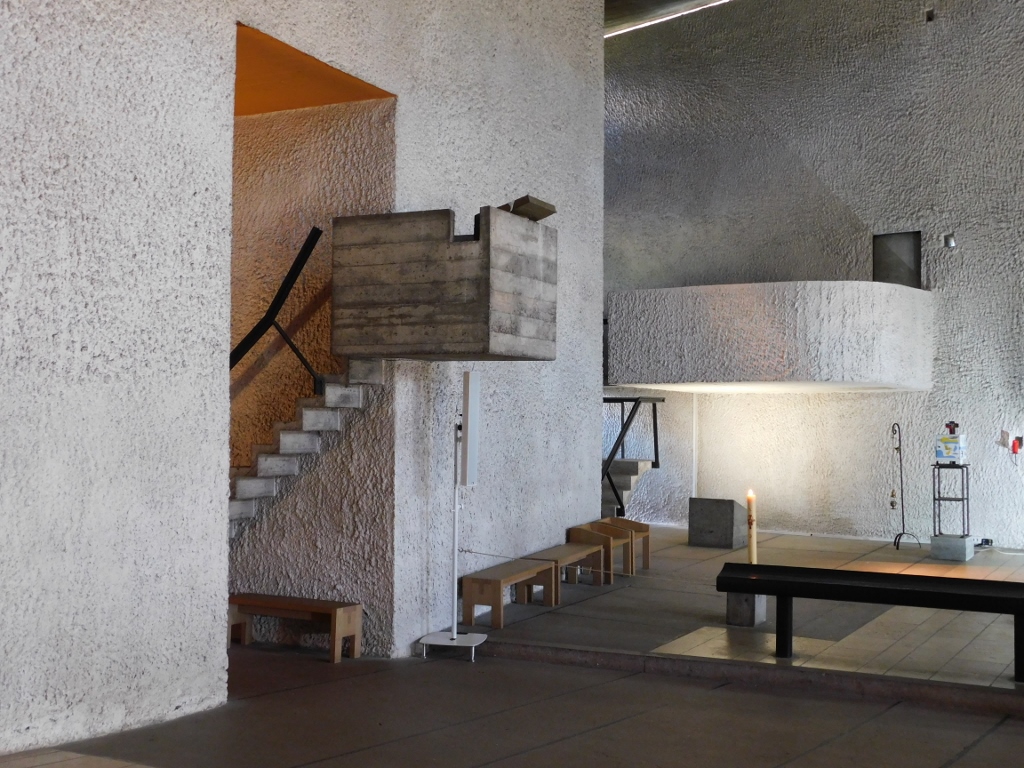 Chapel of Ronchamp: the interior pulpit, as well as the balcony and the door (right) leading to the outside elements for the open-air mass
Chapel of Ronchamp: the interior pulpit, as well as the balcony and the door (right) leading to the outside elements for the open-air mass
In order to get an even better idea of the chapel, primarily about its interior, here is a short video:
It is important to emphasise that this is a working religious building and within the complex there are a few more structures that are a part of a convent. But, I absolutely had no more time for any additional sightseeing, as I was already late with the return of the rented car, while I still had to cover around 90 km to the airport where the parking lot and the office of the rent-a-car company were.
A very essential part of me is that by the rule I am practically never late. This was therefore for me a unique experience, but I could simply not leave the Chapel of Ronchamp out. I even laughed at myself, because as a proper nerd who always obeys the schoolteacher I was worried what I would be told when I returned the car. But I also realised that the “worst thing” that could happen was that they could charge me for yet another day of rental. And that would certainly not be the end of the world, plus I even thought it would be healthy for me to do something I usually don’t do.
So, I got ready for the return and again the navigation device in the car recommended that I should take motorways, since that was shorter in terms of time, although longer in terms of distance. But, I decided, if I was going to be late, I should do it properly. Therefore, I drove along the most direct route, but taking some side roads and going occasionally through smaller settlements. And I loved it! The sights and the landscapes were exceptionally nice, but because of the time situation I did not even think of stopping somewhere and taking photos. I could not introduce too many changes at once into my existence and typical behaviour. Now I was fully concentrated on the drive and so I reached the airport and left the car there. Everything went quite well.
Then I took a bus to get to the railway station in Saint-Louis from where I took a train to Mulhouse.